




Whether you’re an oyster aficionado or you have an adventurous palate, the Jefferson Parish Louisiana Oyster Trail is an experience to savor. Feast your eyes on each restaurant’s life-size oyster sculpture, hand-painted by a local artist which marks the eatery’s recipe for oyster success!
The trail spans the parish and features oysters prepared every which way imaginable. Try Oysters Bienville, Oyster Dressing, Fried Oysters, Charbroiled Oysters, or you can slurp the briny delicacy straight from our Louisiana waters. Our Oyster Trail gets more bountiful every day with new restaurants and dishes. So go to louisianaoystertrail.com, where we’ll tempt you to try the wild side of Louisiana cooking.

Acme Oyster House
Balcony Ballroom, Event Venue
Boulevard American Bistro
Colonial Bowling Lanes
Deanie's Seafood, Bucktown
Don's Seafood
Drago's Seafood Restaurant
Gattuso's Neighborhood Restaurant, Bar & Catering
Grand Isle, Collection of eateries
N.O. Marriott Metairie at Lakeway's Bistreaux Restaurant
Perino's Boiling Pot Restaurant
R&O's Restaurant
Restaurant des Familles
Segnette Landing Restaurant
Short Stop Poboys
The Galley Seafood Restaurant
The Red Maple Restaurant
Town of Jean Lafitte, collection of eateries
Vincent's Italian Cuisine































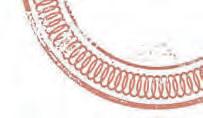
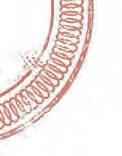


































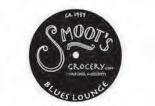




















REFLECTIONS
Cooking for a crowd by James Fox-Smith
Chanterelle hunting, a century of continuing education & 2023’s Ernest Gaines Award winner
32 WHEN PECANS BECAME FRENCH
A primer on French culinary influence in Louisiana by Jordan LaHaye Fontenot
The woman who introduced classic French cuisine to Baton Rouge by Elizabeth C. Weinstein
37 TO FRANCE WITH JANE
An evening at Lafayette’s little slice of Paris by Jordan LaHaye Fontenot
THE SKY’S ALIGHT
Head to the water— fireworks, cookouts & concerts await.
A bayou Cajun chef opens a classic French bakery in prairie country by Natalie Roblin

Photo by Denny Culbert
For a Cuisine issue dedicated to all things French, this mouthwatering shot by Denny Culbert of France’s most emblematic dish was totally irrésistible as a cover contender. This soupe de pauvres has origins in Roman societies— when abundantly-available onions were simmered in water and served as a flavorful broth. Per the enduring lore, the soup’s status was elevated to something fashionable when the former King of Poland Stanislas Leszczynski discovered a version of the dish in an inn on his way to Versailles—where he convinced court chefs to prepare it. A later version, more similar to what is typically served at restaurants today, became a standard late night offering in Parisian restaurants. Its reputation as a hangover remedy earned it the name soupe des ivrognes, “soup of drunks”.
Like many other French dishes, the soup made its way to “the New France” in Louisiana, too. A version is included in the circa 1900 Picayune Creole Cookbook —the oldest official authority on traditional French Creole cuisine. Culbert’s photograph is of the New Orleans brasserie Justine’s version—not currently on the menu but forever preserved in all its cozy, comfort-food indulgence. Bon appétit.
The art of Delta gin by Elizabeth Tettleton Mason
The art of pruning by Jess Cole
by Sophie Nau
MADE IN LOUISIANA
Tony Chachere, a renaissance man by Kristy Christiansen
Fantasy vs. Reality by Megan Broussard
kitschy
to our mascot by Rick Arnett
ON THE DOCK OF THE BAY
The coastal coolness of Bay St. Louis by Mimi Greenwood Knight
CECE MOSELEY
Color and light come together in installations that express the wonders and frustrations of childhood by Mathilde Fox-Smith
Publisher James Fox-Smith
Associate
Publisher
Ashley Fox-Smith
Managing Editor
Jordan LaHaye Fontenot
Interim Arts &
Entertainment
Editor Sophie Nau
Creative Director
Kourtney Zimmerman
Contributors: Rick Arnett, Megan Broussard, Kristy Christiansen, Paul Christiansen, Jess Cole, Shannon Fender, Mathilde Fox-Smith, Mimi Greenwood Knight, Paul Kieu, Nikki Krieg, Lucie Monk Carter, Natalie Roblin, Elizabeth Tettleton Mason, Rachel Tettleton, Elizabeth C. Weinstein
Cover Artist Denny Culbert
Advertising
SALES@COUNTRYROADSMAG.COM
Sales Team Heather Gammill & Heather Gibbons
Operations Coordinator Camila Castillo
President Dorcas Woods Brown
Country Roads Magazine 758 Saint Charles Street Baton Rouge, LA 70802 Phone (225) 343-3714 Fax (815) 550-2272
EDITORIAL@COUNTRYROADSMAG.COM WWW.COUNTRYROADSMAG.COM
No
of this publication may be reproduced without permission of the publisher. The opinions expressed in Country Roads magazine are those of the authors or columnists and do not necessarily reflect the views of the publisher, nor do they constitute an endorsement of products or services herein. Country Roads magazine retains the right to refuse any advertisement. Country Roads cannot be responsible for delays in subscription deliveries due to U.S. Post Office handling of third-class mail.

In Mississippi, our rock stars wear aprons and wield sharp knives.
It takes a creative spirit, an artful eye, and a deep passion for food to become a great chef. Maybe that’s why, in Mississippi, we have a healthy reverence for all those who’ve dedicated their lives to transforming simple ingredients into unforgettable experiences. From classic Southern comfort food to locally sourced and internationally-inspired cuisine, Mississippi is the perfect destination for all those who like their travels flavorful and fulfilling. Learn more at VisitMississippi.org/Flavors.
#WanderMS
It’s hard to believe that almost a year has passed since our youngest child left for college. Since both hhhkids chose schools distant enough to involve air travel, their visits home have been few and far between. With the distance, the occasions we’ve had both kids back under the roof at the same time can be counted on the hand of a clumsy carpenter: Thanksgiving, a few days in January, Easter … and now. This time, both descended in a post-finals avalanche of overweight baggage and unwashed clothing that crested in mid-May and has yet to recede.
As every parent of adult children knows, the departure of the last child on an apparently successful trajectory towards independence elicits a complicated soup of relief, excitement, and sadness. There’s the relief that your kids appear on a path to becoming functional members of society, excitement about regaining a modicum of agency over your daily routine, and sadness at the dawning realization that these people—the stars around which your worlds have turned—will probably never live in your home again (just when they become adults who are
fun to be around). Somehow, you mourn the end of the endless, often exasperating, cycle of mundanities that make a parent’s life simultaneously overwhelming and utterly satisfying: the daily hugs, bedtime stories, pancake breakfasts, box lunches, school commutes, music and sports practices, and the decades of family dinners. On average, our family probably sat down to a home-cooked dinner together six nights a week. For years, few days ended without a table set with spaghetti Bolognese, say, or roast chicken, or lasagna. Chicken and sausage gumbo, minestrone, pond-caught bass, and jambalaya were all in rotation, depending on time of year and the passing fancies of cook and diners. There were thousands of dinners to prepare over the course of twenty-odd years. Until suddenly, there weren’t.
To begin with, of course, it’s wonderful. You come home, look at each other over the top of a wine bottle, someone says, “Cheese and crackers?” And you call it a night. After twenty years of having supper on the table for 7 pm, the freedom to potter in the garden for an hour or two, then come in and have a chicken leg or half a cold sausage feels like the height of luxury. You shop sparingly, eat when you feel like it, and don’t go back to the grocery store until the only things in the fridge are parmesan, mayonnaise,

and half a jar of olives.
Then, in a lovely, chaotic explosion, they’re suddenly home! For days we celebrated with childhood’s greatest hits— spag bol, grilled bratwurst, flank steak with chimichurri, and so on. But while they’ve been away, we’ve apparently lost the intuitive ability to anticipate the warp and weft of the teenaged appetite: that sixth sense that enables parents to always have the right kind and quantity of foodstuffs on hand to keep their needs met. After a couple of weeks, we started to drift back into our new habit of not really thinking about dinner, then just making do with what’s available. The kids were quick to notice … and they didn’t like it.
Realizing the standards might’ve slipped a bit, on a recent Saturday my wife and I planned half a dozen meals, then stocked up on everything: staples,
snacks, steaks, salmon, pounds of chicken, rice, pasta, and so on. Then we spent all Saturday afternoon prepping and cooking various dishes with the goal of leaving a fridge filled with choice morsels to satisfy the hungry natives during the busy week ahead. Then, on Saturday night the kids announced the imminent arrival of a couple carloads of friends for a pool party (“Don’t worry, they’ll bring a pizza!”). The pizza was gone in about four minutes. When it was, they began circling the newly prepared bonanza like jackals. Seeing the writing on the wall, my wife and I took our wine and some cheese and crackers and retreated to the porch. In two hours, everything was gone. Sigh … Back to the grocery store we go.
My mother, who is a marvelous cook not given to effusive declarations of affection, has always said that the way she expresses love is by feeding the people she cares about. I think I’m wired the same way. As surprisingly hard as it’s been to suddenly resume the parental role of daily provisioner, it’s also a joy—a foundational pillar in my life as a parent that I miss when the kids are away, and will forever look forward to reprising on the increasingly rare occasions when they come home.
—James Fox-Smith, publisher james@countryroadsmag.com
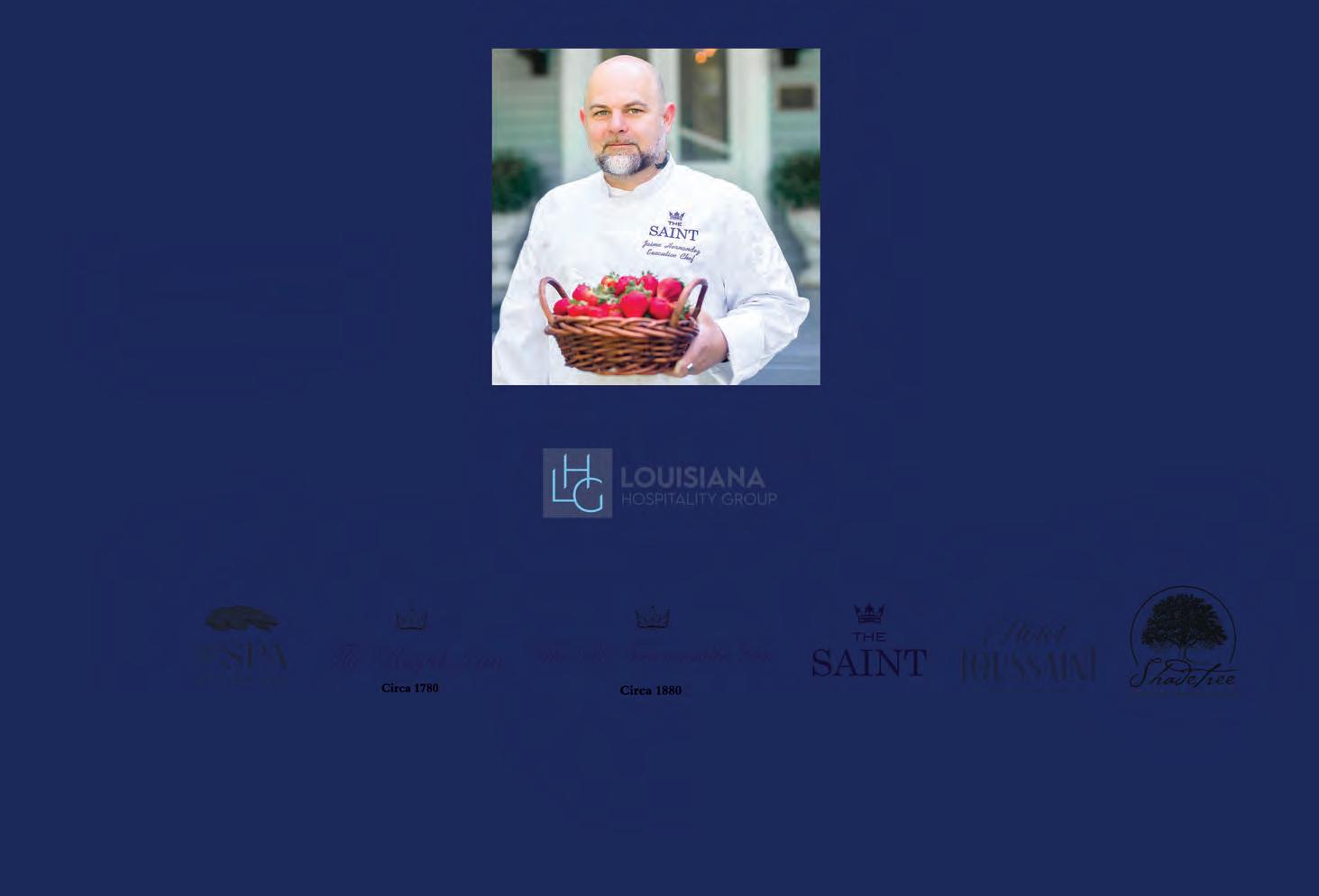

Pennington Biomedical’s Metabolic Research Kitchen develops recipes that support better health through balanced nutrition— and deliver delicious flavor, too. To discover how good, healthy changes can taste, try this summer strawberry mocktail at your next backyard barbecue or pool party.
For nearly four decades, Louisiana State University’s Pennington Biomedical Research Center has stood at the forefront of health and nutrition research. A vital component of the Center’s work takes place in Pennington Biomedical’s Metabolic Research Kitchen , which supports the Center’s dietary studies and nutritional research. In the research kitchen, dietitians and nutritionists design, prepare, and serve specialized meals that meet study-specific criteria. Each day, the kitchen’s staff prepare menus and recipes to exacting standards—sometimes measuring ingredients down to the tenth of the gram. They craft dishes to deliver the specific amounts of calories, protein, fat, and carbohydrates that researchers need to accurately test the impacts of different diets on study participants. And while such precision in food preparation might seem unfamiliar, many of the methods that the Metabolic Kitchen implements can also help home cooks to produce delicious, satisfying dishes, while reducing consumption of unhealthy ingredients. Just in time for the peak of summer, here is a delicious, refreshing recipe for a highly nutritious, icy-fresh drink that’s easy to make and far lower in sugar than typical store-bought alternatives. Try it at your next backyard barbecue or summer pool party. You, your family, and your health will all be glad you did!


Makes 2- 12oz portions
1 portion is 140 kcals, 1g protein, 37g carbohydrate, 2g fiber, 0g fat
Ingredients
1/3 of 1 cucumber, peeled
¼ of 1 jalapeño, seeds and pith removed
1 cup frozen strawberries*
¾ cup orange juice
2 Tbsp honey
Juice from one lime
1 packet (0.8g) True Lemon unsweetened crystallized lemon
½ cup ice
Instructions
1. Add the cucumber, jalapeño, and frozen strawberries to a blender.
2. Combine the orange juice, honey, lime juice, and True Lemon, and pour into the blender.
3. Add ice and blend until smooth.
*Try it with other fruits like blackberries or mango too!
To learn more about Pennington Biomedical’s Metabolic Kitchen and the dietary studies it supports, visit www.pbrc.edu/kitchen


Chanterelle Sauce for Steak or Chicken
½ pound freshly picked chanterelle mushrooms, dried & sliced
1 clove garlic, minced
1 shallot, thinly sliced
2 tbsp olive oil
2 oz white wine
2 tbsp cold butter, cut into small pieces.

Start chanterelles in a dry pan to cook off excess moisture—about five minutes. Once they’ve collapsed, add olive oil, shallot, and garlic. Sauté about three minutes. Add the white wine, and deglaze the pan until all wine is evaporated. Add cold butter piece by piece until a smooth sauce consistency is achieved.
TIME TO TAKE A HIKE
he drought-stricken summer of 2023 meant slim pickings for Louisiana’s chanterelle mushroom foragers. The orange, fan-like mushrooms, which appear as if scattered by fairies in deeply shaded oak and beech groves after early summer rains, simply never emerged, leaving a forager to crunch haplessly through the tinder-dry forest glades where, in wetter times, he collects them by the basketful. So, this summer, the lines of thunderstorms that rolled across the Tunica Hills in late May and early June represented a welcome return to form, bringing an early flush of chanterelles that set the shaded gullies of the deep woods aglow with pops of color unmistakable in the gloom of a rainy afternoon.
After the first couple of wet days, your forager visited some favorite haunts, and came away with a basketful of plump, orange beauties—enough to play a starring role in several days’ worth of omelets, soups, stews, and sauces. It was good while it lasted. When the rain stops, or nighttime temperatures stop dipping below about 70 degrees, the bounty recedes back beneath the leaf litter, to wait for the right combination of warmth and moisture to trigger the eternal cycle to begin again.
Any advice that encourages you to eat mushrooms foraged from the woods should certainly be approached with caution, this example included.* But chanterelles, with their bright egg-yolk coloring, distinctive, fanlike shape, and apricot-like scent, make for easier
(and safer) identification than most. If you want to give foraging a try, the morning after heavy rain, take a basket or paper bag and set off into hilly terrain with mature oak or beech forest cover. Search deep shade beneath mature trees in damp gullies and on hillsides which might run with water during rainstorms. If you find an orange mushroom, pick it and look underneath. If it has prominent, well-formed gills, what you’ve found is a jack-‘o-lantern, which will make you quite sick. The underside of a chanterelle will feature criss-crossed veins as opposed to gills. Slice through the stem. If your stem is a uniform creamy-white color (as opposed to orange) all the way through, you’ve found a chanterelle. Look around. There will usually be more, as clusters of chanterelles tend to emerge in in the same location year after year.
Here in the Felicianas, where mid-June went hot and dry, that flush of chanterelles that burst forth a couple of weeks ago vanished as quickly as it came. But this afternoon, rolling thunder and a stirring in the treetops confirms what the weather forecast has already suggested. The next few days should bring cooler temperatures and lots of afternoon rain. If they do, this forager will be back to his regular haunts, basket in-hand, in search of that loveliest and most ephemeral bounty of a Louisiana summertime.
—James Fox-Smith
*Editor’s note: If you want to start foraging chanterelle or any other varieties of mushrooms, unless you’re absolutely sure what you’ve got, for heaven’s sake don’t eat them. There are many good online resources, such as the Central Louisiana Mushroom Foragers, Hunters, Growers, and Enthusiasts Facebook group where, if you post photos of your find, members will be glad to I.D. it for you.
SINCE THE PROGRAM’S FOUNDING IN 1924, MILLIONS HAVE TAKEN ADVANTAGE OF SKILLS TRAINING COURSES RANGING FROM ART TO EXCEL.
One hundred candles on a hcake—that’s a milestone no matter how you slice it. This year, LSU is celebrating one hundred years of their Online and Continuing Education program. Since its founding in 1924, there have been over two million course enrollments from students that span the globe, who are drawn to the Continuing Education Program’s innovative engine of educational resources for all types of learners.
When I spoke with Senior Director of Professional Development & Community Programs Lisa Verna, an Introduction to Excel class was going on in the other room. “I get here at 7:30 so I can make the coffee [for everyone],” she said. Involved team members are onsite, but
the program’s reach extends far beyond LSU’s campus, with programs that engage learners far beyond the LSU community. As Verna said, “We’re continuously learning ourselves,” and the variety of initiatives over the years have demonstrated that. The College Credit Online program allows students to complete individual courses they can use for credit at their home university. Instructors for professional development have traveled as far as Washington state to conduct onsite training for companies. And continuing education modules are designed for non-traditional students to complete an education in the context of busy family and work lives.
“LSU Online & Continuing Education has always had a keen ability to
stay current with business and industry trends,” Instructor Thomas J. Karam said. “They put together top-notch faculty who deliver practical and valuable information to companies.”
One of the most impactful programs coming out of LSU Online & Continuing Education, according to Verna, is the Louisiana State Science and Engineering Fair, which is targeted towards middle and high school students who have won their regional competitions. Winners move on to the International Science and Engineering Fair, where “they do not have to have a penny in their pocket,” Verna said, making the program accessible to all who qualify.
What’s up next for the program? This fall, the Continuing Education program’s
Osher Lifelong Learning Institute (or OLLI) hopes to open a chapter in New Orleans, joining the active branches in St. Francisville, Baton Rouge, and Camellia City. OLLI caters to students from their fifties to well into their nineties, who have access to volunteer-run classes, from yoga to art history, and membership costs are kept low thanks to support from the Bernard Osher Foundation.
And as A.I. plays an increasing role in the workplace, Verna and her team are looking to add on additional courses in A.I. training. But don’t worry, as Verna said, “we’ll always have programs in Excel.” —Sophie Nau Learn more about the LSU Online & Continuing Education Program at ce.lsu.edu.
AUTHOR AALIYAH BILEL’S SHORT STORY

Fcollection Temple Folk, fiction writing was not always the goal. Bilel is this year’s winner of the Ernest J. Gaines Award for Literary Excellence, an award presented each year by the Baton Rouge Area Foundation to a debut novel by a rising African American writer. The stories in Temple Folk, which was also a 2023 National Book Award finalist, follow the lives of Black Muslims in the United States.
Though the book is inspired by her own experience growing up in a Sunni Muslim family, Bilel has researched Muslim minorities around the world for years, studying in London and in Southern China on a research fellowship. On the heels of a big academic push, she had a moment of clarity other writers dream
“I had finished this master's degree at the University of London, and I submitted my dissertation, which was about the Maulid in East Africa, and specifically in Zanzibar and how they interact with Sufi systems,” she said. “I just was walking across the Thames feeling like I'm a square peg trying to fit myself into a circular hole. And it was in that moment that I had this epiphany, and a story. An entire story came to me while I was standing on the Thames. It was like a revelation from God. Like, ‘Girl, you've been trying to be this academic person, but I made you a fiction writer.’”
She wrote her first story in one sitting, and though she said it’s never going to see the light of day, it lit the fire to understand how to write fiction. Bilel spent the next ten years honing her craft by studying the books she loved, like Tony Morrison’s The Bluest Eye and the works of Edward P. Jones—“When I met him on the page, it was like love at first sight,” she said—studying how the books “seduced” the reader. “I read Maud Martha maybe forty times in those years,” she said.
About three years into her writer’s journey, she wrote “Woman in Niqab,” a story that would eventually appear in Temple Folk. The story follows a woman whose suspicions that her father is cheating prompts her to wear her hair in public. Bilel knew that this was the start of something.
Now, years later, to have her book finally out in the world, she said, “ it just feels so lovely. And I'm exceedingly grateful to the Baton Rouge Area Foundation and to the Ernest Gaines prize for acknowledging this book.”
Bilel’s advice to aspiring writers is to not get discouraged by the gatekeepers of creative writing, and to put the work first.
“It is within all of our capacities to do excellent work and there isn't anything of a technical nature that I or really anybody can tell you that the books cannot explain themselves,” she said. “I just want to encourage everybody that's interested to pursue a writing life, especially in this day and age where we are losing empathy for each other and losing our perspective on the experience of the other.”
—Sophie Nau
Learn more about Bilel and the Ernest J. Gaines Award for Literary Excellence at ernestjgainesaward.org.

The Cajun Capital of Texas tells a familiar story
Some of Jim LaBove’s favorite childhood memories are the nights he spent at his Uncle George’s house, which stood on six-feet pylons on the edge of a saltwater lake. He remembers, “After we’d completed all our work for the day”— fishing, trapping, shrimping, and the like—“we’d go under Uncle George’s house, with kerosene lanterns. Uncle George played the accordion. One of his sons would fill old Coke bottles with different amounts of water and play them with spoons. A cousin fashioned a T’fer out of scrap metal, another played guitar. Another cousin played the harmonica really well, and I played the harmonica poorly.” They’d sing old Cajun classics, like “La Port d’en Arriere,” and it was one of the only times the kids were allowed to speak French with their elders, without being scolded or spanked. “It was such a wonderful time.”

These nights, a time capsule of mid-century Cajun life at its purest, took place not in Louisiana at all, but in Texas—in Port Arthur, known to the Cajun locals as “Port-Ar-Ture” and to everyone else (including the Texas Legislature) as the “Cajun Capital of Texas”.

Explore Port Arthur’s piece in the Cajun story at destinations like the Museum of the Gulf Coast, which features an extensive history on the city, a replica of a traditional Acadian-style home, and a vintage hand-carved pirogue. Learn about Port Arthur’s vital role as home to some of Cajun and Zydeco’s most important artists, including the “Godfather of Cajun Music” and “Fiddle King of Cajun Swing” Harry Choates; as well as where Zydeco forefather Clifton Chenier designed the frottoir while working at the Texaco Refinery. On the outskirts of town, find two other tributes to Cajun culture. Nederland’s Tex Ritter Park hosts an authentic Acadian dwelling, as does Port Neches Park—where you can see the ongoing project of the Les Acadiens du Texas organization to restore a circa-1810 cypress home built in St. Martin Parish. On occasion, locals even celebrate a French Mass within its storied walls.
To immerse yourself in the Texas side of “Sportsman’s Paradise,” head out to Sea Rim State Park, where

LaBove’s family are among the hundreds of Acadian descendants who embarked on the “second diaspora” of the Louisiana Cajun people. Following the devastation of the Great Mississippi Flood of 1927—the most destructive river flood in our nation’s history—people who had depended on the river and the lands surrounding it for their livelihoods turned West. Not only did Port Arthur, with its coastline and salt marshes, closely resemble the landscapes and ecosystems the Cajuns had long called home; but it also offered a path out of poverty. The area was quickly becoming a center of the country’s emerging petrochemical industry, and well-paying jobs were abundant at the new refineries.


When you go:
5.2 miles of shoreline and 4,000 acres of marsh are home to a diverse ecosystem of creatures feathered and finned. Experience it on foot, via kayak, or you can even spend the night on the floating campsite in the heart of the marsh. Port Arthur even offers swamp tours, where you can learn from local boat captains the intricacies of the marsh environment and its wildlife, and get up and close to gators.

Find delicious Cajun-style eats at beloved local restaurants like Judice’s 1927, which pays tribute to the Judice family’s origins in Port Arthur, when Al Judice Sr. (known around Texas as “The Crazy Frenchman”) left Loreauville to open the first Judice’s French Market. Today, the restaurant offers elevated Cajun recipes. Get all your fresh-from-the-
On his mother’s side of the family, LaBove’s grandfather came to Port Arthur in the 1920s to work in the shipyards, “and he was able to continue trapping and hunting and fishing just like he did in the Atchafalaya Basin,” he said. His paternal grandfather, on the other hand, saw the opportunity in a growing community of working class Cajuns. Originally from Cameron, he moved his family across the Sabine River to set up whiskey stills where the authorities were less likely to bother with him: in the mosquito-infested salt marshes of Southeast Texas. “Cajuns have always been a little hostile to authority,” laughs LaBove.

And as they did when they were forced to move from Acadie to Louisiana, the Cajun people held tight to their identities. To this day, Louisiana Cajuns would find themselves right at home in Port Arthur, where their cousins have cultivated a world where French is heard on the radio, there is need for a local accordion maker, boudin is served at all the gas stations, and Saturdays are spent at the local restaurantdancehalls. Port Arthur is even home to Texas’s largest concentration of gators!
Gulf, hot’n’ boiled or fried crawfish, shrimp, crabs, and more at boiling houses like Reel Cajun Seafood Restaurant and Bar or Touch of Cajun Café. The Schooner Restaurant claims to serve the “best seafood in Texas,” as well as gumbo by the gallon.
And on your way out be sure to grab a greasy piece of boudin from a local grocery or gas station. We recommend Big Doobie’s Boudin & Cracklins, where you’ll likely be enticed to stay by local and Louisiana Cajun and Creole performers.
As LaBove, who has built a career as a Cajun author and illustrator, puts it: “With Cajuns, there’s always an excuse to party. It’s always a fais do do.”

Learn more about Jim LaBove’s books and artwork at cottons-seafood.com and explore everything Port Arthur has to offer at visitportarthurtx.com.
CRACKLE AND FIZZ FOR YOUR INDEPENDENCE DAY INDULGENCE, LIVE MUSIC INDOORS AND OUT, AND A WHACK WITH A WHIFFLE BALL BAT • JULY 2024


From Vicksburg (pictured) to Lake Charles, to Slidell and a hundred places in between, cities and towns around the region will launch Independence Day celebrations this July 4 that offer uniquely curated opportunities to experience local landmarks, talents, and flavors at their best. You'll find a representative sample on the pages that follow. Then visit countryroadsmagazine.com/events-and-festivals for more.
of
Celebrations in Cajun Country & Southwest LA
June 30
Acadian Wind Symphony’s "Celebrate America!" Concert at the ACA: The nationally-acclaimed Acadian Wind Symphony presents “Uncharted Journey” by local composer Andrew Morgan Smith, in the James Moncus Theatre at The Acadiana Center for the Arts. 3:30 pm. $20. acadianacenterforthearts.org. 1
June 30–July 4
Erath Independence Day Cajun Carnival: One of the oldest July 4 celebrations in Acadiana, this festival is full of rides, fais do-dos, Fire Department water fights, a fun run, a parade, and more. Expect live performances by local musicians like Alligator Blue, Jace Richard, Dustin Sonnier, The Chee-Weez,
and Geno Delafose. Fireworks at 9 pm. Free. erath4.com. 1
July 3
Youngsville Sugar Mill Pond
Independence Celebration: Meet at the pond and enjoy live music, family-friendly activities, pop up vendors, food from Bon Temps Concessions, and fireworks. 5 pm–9 pm. Free. Details at the Sugar Mill Pond Facebook Page. 1
Jennings Stars & Stripes Celebration and Fireworks Show: This outdoor community festival at Founders Park hosts a barbecue contest, food trucks, markets, games, and live music. 6 pm. Free. Details at the Jennings Festival Association Facebook Page. 1
July 4
Old Fashioned July Fourth Celebration: Celebrate at DeRidder's Beauregard Parish Fairgrounds. Expect a DJ, fireworks, food trucks, and a good old fashioned time. 7 pm–9 pm. cityofderidder.org. 1
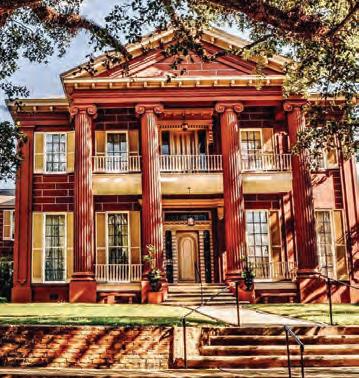

Lake Charles Red, White, Blue & You Celebration: Voted one of the "Top 20 Events" for July by the Southeast Tourism Society—this celebration paints the town patriotic with a starspangled street parade, concessions, face painting, and huge fireworks over the water from the Lake Charles Civic Center. The Lake Charles Community Band’s 25-piece “Bayou Big Band" play at 6 pm, with The Flamethrowers to follow at 7 pm. visitlakecharles.org. 1
Fourth of July Lake Jam: Come by car, boat or whatever to celebrate America at Morgan City's Lake End Park with a boat parade, food trucks, live music, a Kid Zone with water inflatables, a fireworks show finale and more. The music lineup includes Cliff & Sidepiece Band, and Shorts in December. 3 pm–9 pm. Free. cajuncoast.com. 1
Broussard Independence Festival: It's a big ole birthday party for the nation, Broussard-style. Expect family friendly activities (hot dog eating contests!), live music by Louisiana Red, and fireworks at the St. Julien Park Sports Complex.






5 pm–9 pm. Free. Details at the Broussard Chamber Facebook Page. 1
Krotz Springs Fireworks on the River: The name says it all—head for the Atchafalaya for a sportsman's paradise fireworks show in Nall Park, 562 Front Street. The little town goes the whole nine yards with hot dogs, watermelon for miles, and live local music. 6:30 pm–8 pm. cajuntravel.com. 1
New Iberia's Fourth of July Salt Water Fishing Rodeo: It's a yee-haw good time on the water, come full circle with a bit of fais do-do under the pavilion (for an extra independence vibe, call the fish "Cecil" and make fun of its teeth). At the Quintana Boat Launch at Cypremort Point. Fishing begins at 12:01 am Thursday and ends at 10:30 pm Saturday. This year's lineup includes performances by Seasoned Soul, Cliff Bernard, Swampland Revival, and The Bad Boys. Free. (337) 207-6206 or iberiarodandgunclub.com. 1
Mandeville's Light Up the Lake: On the Mandeville Lakefront, the fireworks will be beautiful mirrored in Lake Pontchartrain—providing a sure "fire" way to ring in the Fourth. With patriotic tributes and live music, a kid's tent, games, face painting, and food trucks, the fireworks are not the only thing to look forward to. Onstage entertainment, located between Coffee and Carroll Streets, begins at 6 pm. Fireworks begin at 8:30 pm and will be launched from a raised barge for prime viewing all along the lakefront. Picnics are encouraged. Free. louisiananorthshore.com. 1
Madisonville Old Fashioned Fourth of July Celebration: The town of Madisonville and Keep Madisonville Beautiful invite all to this old fashioned

celebration on the banks of the Tchefuncte River. Bring your chairs, coolers, and picnic baskets, and find a spot on the riverfront to enjoy the fun. Bring the kids, there's going to be cornhole and horseshoe tournaments, a Veteran's Salute, watermelon eating and rooster crowing contests, a pie bake-off, and fireworks in front of Old Town Hall. The fireworks start around 8:45 pm. Free. 10 am. louisiananorthshore.com. 1
Abita Springs' Fourth of July Celebration: Abita Springs’s festival offers patriotic excitement for the whole family, with a classic car display from Gulf Coast Classic Cruisers, live music, fireworks, face painting, and food from favorite vendors. Additionally, the Abita Beer Truck and other drinks will be available for purchase all day. Free. 2 pm–9:30 pm. louisananorthshore.com. 1


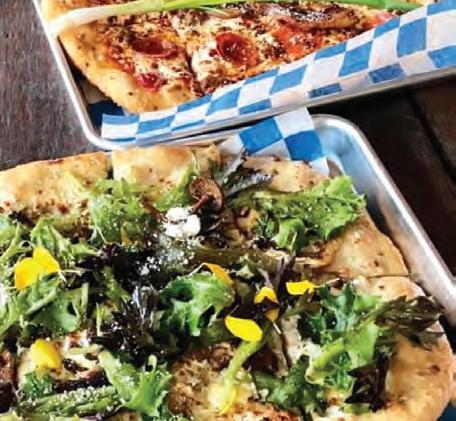








Rock the Red Independence Day Celebration: Head to Alexandria City Hall for a freedom celebration featuring a sky lit up with sparkles, delicious food, and live music from DJ Tony Groove, The Rouge Krewe Party Band, and J. Paul Jr. and the Zydeco Nubreedz. 5:30 pm–9:30 pm. cityofalexandriala.com. 1
Shreveport KTBS Freedom Fest: Fireworks will be launched from sites all around Shreveport, across from the Sci-Port Discover Center, backdropped by the lights on the Texas Street Bridge, and in the Brookshire Arena in Bossier City, the Northwood Country Club in Blanchard, over Big Cypress Bayou, and at the Maude Cobb Convention Complex. On the ground, revelers will get live performances

at the Northwood Country Club in Downtown Shreveport. Food trucks will be doing their thing at South Bossier Park and Louisiana Boardwalk Outlets. Fireworks begin at 9:30 pm. Free. sbfunguide.com. 1
July 5
Independence Day Celebration in Monroe-West Monroe: Settle in downtown on the west or the east to watch the highly anticipated annual fireworks show. All day, local vendors will be peddling wares, and the streets will be filled with the sounds of live bands. Fireworks from 9 pm, over the Ouachita River—best viewed from downtown West Monroe or Monroe, or on the West Monroe levee. Free. monroe-westmonroe.org. 1
Kenilworth Independence Day Parade: Having trinkets, candy, and other treasures flung from passing floats is a time-honored tradition in Louisiana, so why not bust it out for America's birthday, too? Kenilworth celebrates its 52nd Annual Independence Day Parade. Rolls at 6:30 pm. For route information and more, visit kenilworthneighborhood.com. 1
Donaldsonville’s Fireworks on the River: Crescent Park comes alive with live music by the Michael Foster Project and other acts all afternoon before the fireworks—this historic little town puts on a good show. 4 pm–10 pm. Free. visitlasweetspot.com. 1
4
Baton Rouge Fourth of July Spectacular: Every year, for our nation's birthday, WBRZ lights up the sky above the Mississippi River. The fireworks can be viewed from anywhere along the levee, and from downtown Baton Rouge, from 9 pm. visitbatonrouge.com. 1
LSU Museum of Art and Tsunami Baton Rouge Fourth of July Annual Celebration: Enjoy a colorful sushi dinner by Tsunami, fireworks, music and more at Fourth of July Celebration presented by LSU Museum of Art. VIP tickets $165. GA tickets $85. Terrace access only tickets $25. 7 pm–10 pm. lsumoa.org. 1
Baton Rouge Concert Band: the Main Library at Goodwood for the beloved ensemble's traditional concert, featuring compositions by Sousa, Irving Berlin, and Morton Gould, including "America, The Beautiful" and "American Salute". Wear red, white, and blue, bring flags. 7 pm. ebrpl.com. 1
Annual Plaquemine Hometown Celebration: At Plaquemine's 23rd annual Fourth fest at Bayou Plaquemine Waterfront Park, expect old-fashioned games, a veterans' boat parade, food, crafts, live music, dancing, a jitterbug contest, and a fireworks display. 5 pm–9 pm. postsouth.com. 1
St. Francisville's July Fourth in Parker Park: Enjoy live music from the gazebo, food trucks around the perimeter, plenty of room under the live oaks for lawnchairs and picnic blankets, and fireworks overhead from 6 pm. Free. Details at the Town of St. Francisville Facebook Page. 1







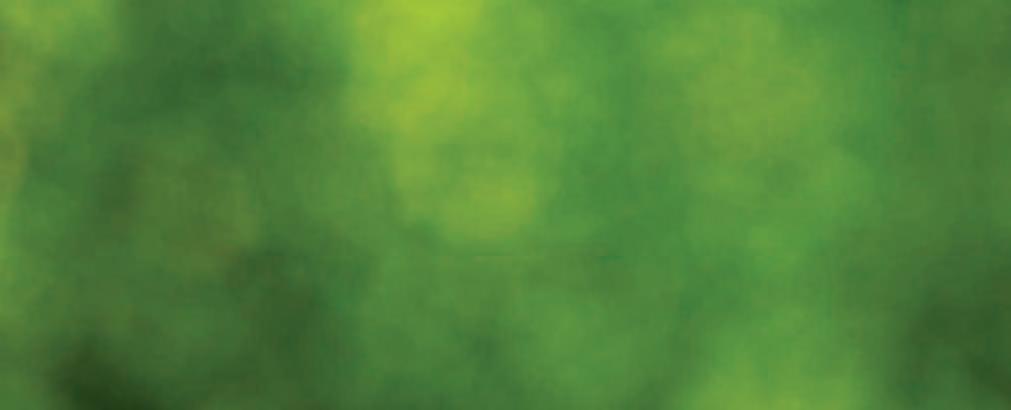
Happy Third of July: Yes, you can celebrate our great nation on July 4, but you can also show your pride yearround—July 3 included, at City Park in New Orleans. Bring your chairs and blankets to enjoy patriotic music with The Marine Corps Band on the Goldring/Woldenberg Great Lawn and fireworks at the Peristyle. Bring a picnic. A dress code of red, white, and blue is definitely recommended. 7:15 pm. Free and open to to the public. neworleanscitypark.com. 1
Go Fourth on the River: The Mississippi River has long linked the people of this region to the rest of America, and on our country's birthday, the people of New Orleans
invite all to "Go Fourth" in celebration. Come down early to experience the attractions/shopping along the Riverfront. Then, starting at 9 pm on both sides of the Mississippi, fireworks will shoot and scream into the sky from the banks and from barges, accompanied by patriotic songs. Settle in anywhere between Governor Nichols St. Wharf and Canal St. Dock. Free. go4thontheriver.com. 1
Fourth of July on The Creole Queen: Celebrate independence on the open water, watching fireworks from the decks of the paddlewheeler, The Creole Queen . This catered dinner cruise offers the best seat in the house to view the "Dueling Barges" fireworks that the city launches above the Mississippi. $129 adults, $69 youths (ages 6–12), and $20 children (ages 3–5). Boarding from 7 pm to 8 pm, at Poydras St. Wharf/ Spanish Plaza. Reservations required. creolequeen.com. 1
St. Charles Independence Day Celebration: St. Charles Parish will hold its Independence Day celebration at West Bank Bridge Park, featuring
performances by popular band Sugar Shaker and food and drinks sold by local nonprofits. A firework show closes out the night. 6 pm–9:30 pm. 13825 River Road. Free. stcharlesparish-la.gov. 1
Ocean Springs Fireworks Show: Fireworks will set the sky aglow from the front beach of Fort Maurepas park; bring blankets, chairs, and a competitive spirit for the volleyball court. 6 pm–9 pm. oceansprings-ms.gov. 1
Vicksburg's July Fourth: It'll be raining stars, stripes, and fireworks in downtown Vicksburg. Head to Washington Street between Jackson and Grove for an Independence Day celebration featuring a live music performance by Dr. Zarr. 7 pm. (601) 630-2929. For an all-day celebration
join the Mulberry Hotel for a pool party with live music. 4 pm–9 pm. (601) 301-2500. 1
Natchez Fourth of July Fireworks: Join the party at the Natchez Bluff to celebrate Independence Day. Expect a booming firework show to cap things off at 9:30 pm. Free. visitnatchez.org. 1
Fireworks in Biloxi: Gear up for eighteen minutes of wonder set for 9 pm off of Biloxi's coastline, viewable from the lighthouse eastward to the Biloxi Bay Bridge. gulfcoast.org. 1
Fireworks in Gulfport : Shot from the Moses Jetty, fireworks will light the sky starting at 8:45 pm with viewing areas from Jones Park, the Gulfport Marina, and the beach south of 90. gulfcoast.org. 1
Mississippi Deep Sea Fishing Rodeo: The annual rodeo is always an ode to the Fourth, with a bang-up fireworks display from the Gulfport Harbor in Jones Park, but the four-day festival also brings live music, karaoke, kids events, a midway, and more. mississippideepseafishingrodeo.com. 1



The annual St. Francisville Food & Wine Festival is a weekend-long celebration of the culinary culture of Louisiana and Mississippi with acclaimed chefs, creative wine pairings, cocktail and spirit tastings, craft beer and live entertainment in one of Louisiana’s most beautiful and historic small towns.
Three days of Food & Wine Festivities:
Friday, November 8
Jazz Brunch at the St. Francisville Inn Winemaker Dinner at Magnolia Café featuring Eberle Winery
Saturday, November 9
Bubbles and BBQ at North Commerce
Mad Hatter Soirée at the Royal Inn
Sunday, November 10
St. Francsiville Food & Wine Festival Grand Tastings at The Myrtles







Beginning July 1st - July 5th
VISUAL ART
CERAMICS NOW: CONTEMPORARY & TRADITIONAL PRACTICES IN ACADIANA
Lafayette, Louisiana
Taking center stage in the Main Gallery at the Acadiana Center for the Arts this summer is the most comprehensive survey of ceramicists in the region to date. Ceramics Now: Contemporary and Traditional Practices in Acadiana, ACA's annual juried group exhibition, features work by more than sixty artists. Pieces range from functional and traditional forms, to purely visual and avant-garde pieces. Collectively, the exhibition presents an opportunity to discover the breadth and depth of ceramic art being created in Acadiana today. acadianacenterforthearts.org. 1
COMEDY "I USED TO BE FUNNY" SCREENING
Baton Rouge, Louisiana
Each month, the Manship Theatre offers an engaging lineup of films and entertainment
you won't find at the megaplex. This month, catch I Used to Be Funny, starring the darkly humorous Rachel Sennott, who has recently performed roles in Shiva Baby and Bottoms. In this debut feature from Ally Pankiw, Sennot plays a stand-up comedian struggling with PTSD after a girl she used to babysit goes missing. 7:30 pm. $12.50 manshiptheatre.org. 1
FAST FEET
HAPPY'S RUNNING CLUB
Baton Rouge, Louisiana
After disbanding for a while for COVID, Happy's running club is back to tearing through the streets of downtown Baton Rouge on a quest to make participating runners extremely thirsty. Choose between distances of 5K or just over three miles (whichever you prefer). During daylight savings time, live music promises a lively post-run reward. Every Tuesday at 6 pm, rain or shine. $35 annual membership, which includes food and drink specials after the run and a technical dry-fit shirt. For more information, email contactus@ happysrunningclub.com. 1
ART EXHIBITIONS
ALEXANDRIA MUSEUM OF ART 37TH ANNUAL JURIED EXHIBITION
Alexandria, Louisiana
Each year, the Alexandria Museum of Art hosts a juried exhibition selected from national and international submissions with a focus on contemporary art practices. This year's guest juror is David Butler, the Director of the Knoxville Museum of Art. A member opening reception will be held Friday, July 12 at 6 pm. $5; $4 senior citizens, students, and military. Free for children under 4. Call for group rates. themuseum.org. 1
OUR CATFISH CENTURY MIDDENDORF'S TURNS 90
Akers, Louisiana
Legendary restaurant Middendorf's is turning 90! Join the restaurant at both its Manchec and Slidell locations throughout Fourth of July weekend for live music, giveaways, and surprises (a live alligator, anyone?). On Thursday, the restaurant will be giving out slices of cake while Chris Broussard and Christian Serpas & Ghost Town rock the porches of Manchec and Slidell, respectively. Live music from 3 pm. middendorfsrestaurant.com. 1
ARTS & SPARKS
AVOYELLES ARTS & MUSIC FEST
Marksville, Louisiana
This year, the Avoyelles Arts and Music Fest is leveling up to the state-of-the-art venues at Paragon Casino Resort, thanks to a new partnership between the Arts Council of Avoyelles, the Tunica-Biloxi Tribe of Louisiana, and Paragon. The celebration kicks off with a tried and true parade from 10 am and features live music by Cupid, Lil' Nathan and the Zydeco Big Timers, Amanda Shaw, Rusty Metoyer, and the Chase Tyler Band. The classic car show is always a favorite, as is the barbecue cook-off, and interactive games and rides for the little ones. Fireworks close out the fun at sundown. Free. avoyellesarts.com. 1
CRUSTACEAN NATION
OUR LADY OF THE GULF CRAB FEST
Akers, Louisiana
The Fourth of July weekend in Bay St. Louis brings Our Lady of the Gulf's 40th annual Crab Festival. That means seafood, live music, rides, and craft booths. Highlights include a 5k run on Saturday and a golf cart raffle. This year's music features the Dave Maley Band, the Bay Town Groove, Kings of Neon, Beau



King and Riley, Ross Grisham, Ryan Foret and Foret Tradition, and more. Free. olgchurch.net. 1
JUL 4th - JUL 6th
FUN WITH FISH GOLDEN MEADOW FOURCHON TARPON RODEO
Port Fourchon, Louisiana
They don't make a great meal and they're not particularly good to look at, but they sure are fun to fight with ... but enough about my exes! (I'll be here all week.)
Come to the wonderfully named Golden Meadow for the Tarpon Rodeo. There's the prospect of tarpon to catch for the anglers, and plenty of food, music, and seaside fun for those who prefer their seafood pre-scaled. $35 registers adults for the rodeo and also gives access to the air-conditioned entertainment tent and a boiled shrimp dinner (not to mention the chance to win over $15,000 in rodeo awards and door prizes). Details and schedule at fourchontarpon.com. 1
JUL 4th - JUL 25th
FRESH PICKINS
THURSDAY FARMERS MARKET
Baton Rouge, Louisiana
BREADA's Red Stick Farmers Market makes a weekly appearance at Pennington Biomedical Research Center on Perkins— offering the usual fresh, local veggies, meats, seafood, prepared foods, jarred and baked treats, and more. 8 am–noon.
While you’re there, join in on the free yoga class offered by Baton Rouge Yoga Nation. 9 am–10 am. Free. breada.org. 1
JUL 4th - JUL 25th
SONGBIRDS
JOIN SWEET ADELINES
Baton Rouge, Louisiana
If your 2024 resolution involved lifting your voice in song, the friendly women of The Baton Rouge Chorus of Sweet Adelines invite all women to join their
weekly rehearsal sessions. The group, going strong for sixty-two years, is dedicated to the performance, education, and sharing of four-part harmony, acapella barbershop music. Chorus rehearsals take place each Thursday at the Ingleside United Methodist Church from 6:30 pm–8:30 pm. batonrougechorus.org. 1
JUL 5th
LIVE MUSIC
FIFTH OF JULY FUNK
THROWDOWN
Bay Saint Louis, Mississippi
Good Earth Records, T-Fat Entertainment, and The Bay St. Louis Little Theatre are joining forces to bring the incomparable sounds of NOLA funk to the beachside theatre's stage. Expect all seats to be cleared to make way for a proper dancefloor when Crescent City funkmasters, Flow Tribe with Valerie Sassyfras, head east to Bay St. Louis. Doors at 6 pm, Valerie Sassyfras from 7 pm, Flow Tribe from 8 pm. 398 Blaize Avenue. $25. bontempstix.com. 1
JUL 5th - JUL 7th
BLACK MAGIC
ESSENCE FESTIVAL
New Orleans, Louisiana
Some massive acts are headlining this year’s Essence Music Festival, the annual showcase of African-American musical talent hosted by Essence Magazine, which brings some star-studded names to a city that isn't easily impressed by superstar musicians ... including Birdman & Friends, Janet Jackson, Charlie Wilson, SWV, our own Tank and the Bangas, The Roots, Big Boi, Donnell Jones, and T-Pain, to name a few. This year, the festival celebrates thirty years since the magazine decided to mark its twentyfifthth anniversary with a weekend celebrating the many accomplishments of Black culture-makers, which subsequently turned into one of the country's most

July 5th - July
esteemed events. In additional to offering superb celebrity and music, the festival— held at the Caesar's Superdome—provides inspirational and business-related seminars, and markets showcasing work by African American writers, crafters, and visual artists. Weekend passes from $226.50. essence.com/festival2024-v2. 1
COMING OF AGE
COOL CAREERS AT EBR LIBRARY
Baton Rouge, Louisiana
Come learn about in-demand careers from industry experts at the Cool Careers series, open to teens and twentysomethings curious about exciting career paths and the steps to take to start them.
July 5: "Drones and Robotics" with LSU, BRCC, and Atmosphere Drones
July 12: "Forensics" wit h LSU FACES Lab
July 19: "Healthcare" with Oncologist Sanjay Juneja, M.D. and Oschner Health For more details and to register, visit careercenterbr.com/events or call 225231-3733. Fridays at 10 am. Free. 1
TIPITINA'S CONCERT SCHEDULE
New Orleans, Louisiana
The famous Tchoupitoulas venue continues bringing a wide variety of New Orleans' favorite musical acts to Professor Longhair's legendary stage. Here's what's happening:
July 5: Free Friday featuring Sierra Green & The Giants and Sporty's Brass Band. Doors 8 pm, show 9 pm.
July 6: DJ RQ Away Presents:
Lagniappe and Juice. Doors 10 pm, show 11 pm. July 12: Free Friday featuring Naughty Professor and Whisper Party. Doors 8 pm, show 9 pm.
July 14: Fais Do-Do with Bruce Daigrepont Cajun Band. Doors 4:45 pm, show 5:15 pm.
July 19: Free Friday featuring Honey Island Swamp Band and Renée Gros & Tiago Guy. Doors 8 pm, show 9 pm.
July 26: Erica Falls & Vintage Soul and Zita. Doors 8 pm, show 9 pm.
July 27: The Iceman Special with special guests Diamond J & the Ruby
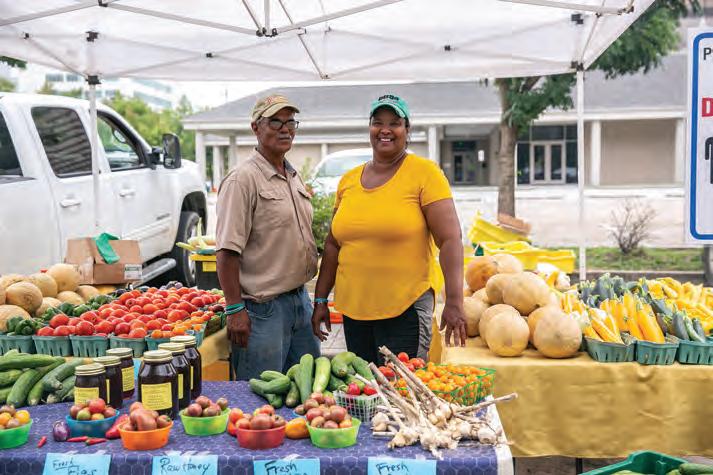
Red Raindrops, featuring Roddie Romero and The Quadroholics; and the Krewe de Void Summer Meltdown. Doors 8 pm, show 9 pm.
Ticket prices at tipitinas.com. 1
JUL 6th
FOOD FEST
LEBEAU ZYDECO FESTIVAL
Lebeau, Louisiana
Immaculate Conception Church lures zydeco lovers back to this tiny Louisiana hamlet with a top-notch lineup of heavy-hitters. Bring your Toot
Toot out to the home of legend Rockin' Sydney. Adults $20; children $10. 9 am–10 pm. cajuntravel.com. 1
JUL 6th
COOL MUSIC
MIDSUMMER JAZZ ON THE BAYOU
Baton Rouge, Louisiana
Saxophone extraordinaire ScoSax returns to the Manship for a night of music and entertainment. Experience an exciting lineup of performers showcasing the region's signature sound. 7:30 pm. $45. manshiptheater.org. 1

6th
HANDMADE HEAVEN
BATON ROUGE ARTS MARKET
Baton Rouge, Louisiana
Shop with artists from Louisiana, Mississippi, Texas, and Florida who present original works of art in mediums including pottery, jewelry, woodwork, textiles, photographs, glass, paintings, sculpture, handmade soaps, and more. Performances enliven the arts on display. A children's activity center sets up between 8 am and noon. Held alongside the weekly Red Stick Farmers Market the first Saturday of each month. Corner of 5th and Main streets. Free. artsbr.org. 1
JUL 6th - JUL 27th
FRESH PICKINS
FRESH FEST
Baton Rouge, Louisiana
Throughout the early weeks of summer, when the spectacular bounty of Louisiana farms reaches its peak, the Red Stick Farmers Market sets into motion a series of themed events at its Saturday downtown markets. From local chefs demonstrating seasonal cooking tips to live music, art, and garden activities—each week puts the focus on a regional crops. Here's the July schedule:
July 6: Melon Mania
July 13: Everything Eggplant
July 20: Positively Pepper

On July 11–12, the Acadiana Center for the Arts transforms into the divine spheres of Heaven and Hell with Holy Animals, a live dance and theatre performance based on Dante's Divine Comedy See listing, page 20. Photo courtesy of the ACA.
July 27: Oh My Okra! breada.org. 1
JUL 6th - JUL 27th
FUN IN THE SUN SATURDAY AT THE PADDOCK MARKET Folsom, Louisiana
Don't' miss Folsom's intimate and funky farmers' and artisans' market,
which runs 10 am–2 pm each summer Saturday at Giddy Up Folsom. The event attracts a symbiotic community of producers and consumers of fresh grown produce, prepared food, local art, handcrafted goods, local coffee brewers, and music—the folks at Giddy Up have curated an environment that's hard to beat. Free. giddyupfolsom.com. 1
JUL 6th - JUL 31st
PHOTO EXHIBITION "LEPROSY, THE SEPARATING SICKNESS" AT WETLANDS ACADIAN CULTURAL CENTER Thibodaux, Louisiana
Leprosy, The Separating Sickness, an exhibition of photographs by Johnny Harmon, opens at the Jean Lafitte Historical Park's Wetlands Acadian Cultural Center this month. Harmon, who was a patient at the Carville Leprosarium south of Baton Rouge, the only leprosarium in the United States— now a museum—resigned himself to the colony when he was struck by the disease, but his photographs capture the humanity he discovered amongst his fellow patients and the life they made as outcasts from society. Gallery hours are Tuesdays 11 am–7 pm. Wednesdays–Saturdays 9:30 am–4 pm. Free admission. nps.gov/jela. 1
JUL 7th
ART EXHIBIT
TINA GIROUARD: "SIGN–IN" AT THE OGDEN
New Orleans, Louisiana
The Rivers Institute for Contemporary Art & Thought and the Ogden Museum of Southern Art present a retrospective honoring the Louisiana-born artist, Tina Girouard and her eclectic career. From her avant-garde collaborations in New York to her immersion in Haitian culture, this exhibition offers a glimpse into Girouard's multifaceted journey through performance, film, textile, and community-based art. ogdenmuseum.org. 1
FREE INSPIRATIONS
FIRST SUNDAYS AT DOWNTOWN ART HOTSPOTS
Baton Rouge, Louisiana
On the first Sunday of each month, the LSU Museum of Art and Louisiana Art & Science Museum open their doors— behind which are high caliber art and science exhibitions, as well as family activities, live music, and more—free of charge. What's more, the museums are within walking distance of each other. Make an afternoon of it. 1 pm–5 pm. lsumoa.org. lasm.org. 1
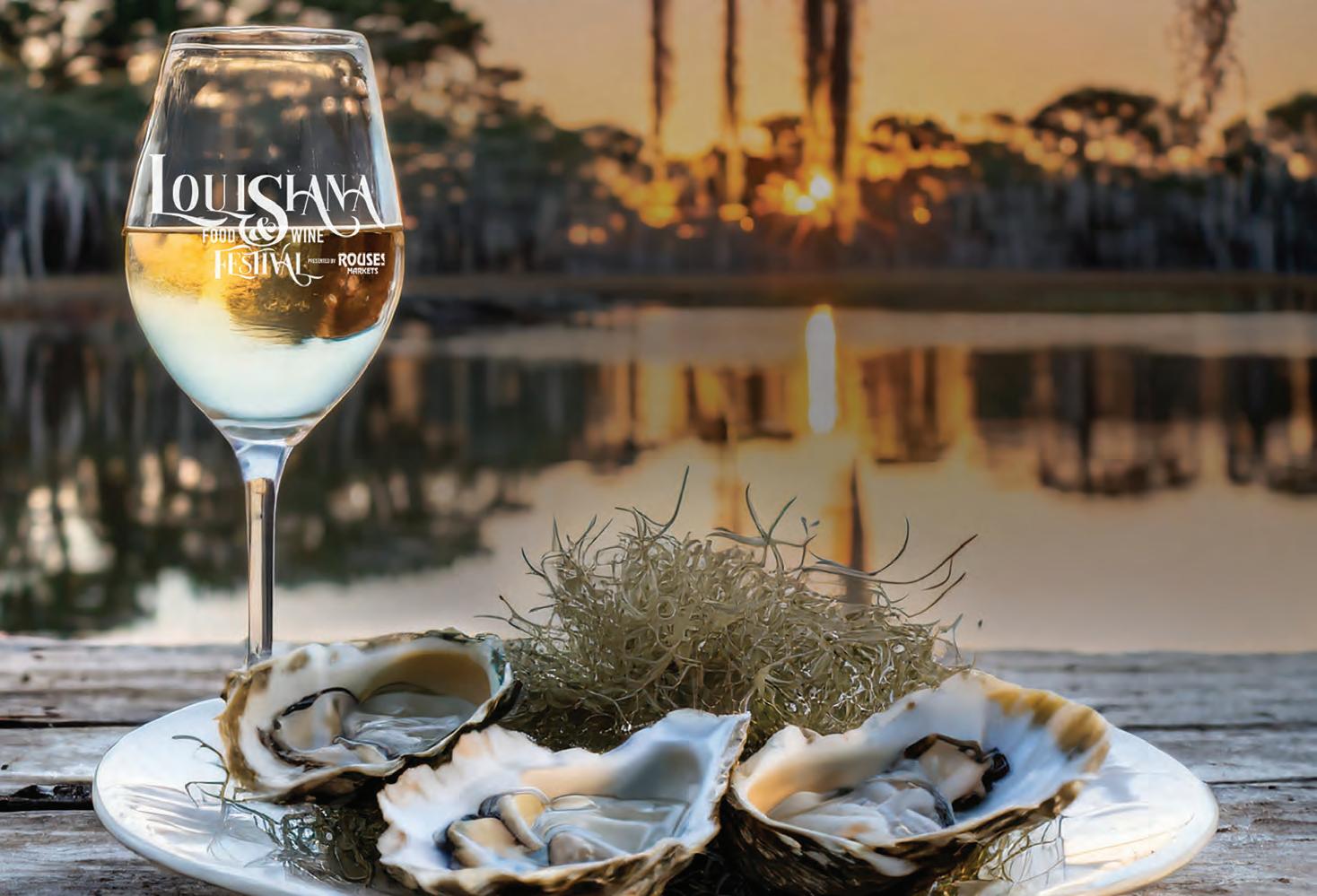

SEPTEMBER 19 - 22, 2024 Lake Charles, Louisiana
The Louisiana Food & Wine Festival is a showcase of Louisiana’s unique culture and cuisine, from its culinary superstars and beverage experts to its artisans and live music. Enjoy a variety of all-inclusive food and drink tasting events with celebrity guest chefs and hundreds of varieties of wine, beer and spirits.

7th - July 11th
JUL 7th
READINGS
AUTHOR TALK WITH MICHAEL H. RUBIN AT THE OLD STATE CAPITOL
Baton Rouge, Louisiana
Join author Michael H. Rubin at the Old State Capitol as he discusses his book, The Cottoncrest Curse, a heart-pounding thriller that weaves together the histories of Louisiana's plantations and Cajun country. In this saga, spanning over one hundred years, a Jewish immigrant who flees the Czar of Russia and winds up on Cottoncrest Plantation must reinvent himself again to escape wrongful murder conviction. 1:30 pm–2:30 pm. Free. louisianastatecapitol. org. 1
JUL 7th
HANDS ON BEHIND BARN DOORS
Port Allen, Louisiana
The first Sunday of every month, learn a historic artisanal skill at the West Baton Rouge Museum. This month's will feature blacksmithing with Ben Deshotels, tinkering with Gary Hart, and tatting with
Christy Benoit Castille, all set within the charming ambiance of the Big Red Barn. 2 pm–5 pm. Free. westbatonrougemuseum. org. 1
7th - JUL 28th
ARTS & CRAFTS
MADISONVILLE ART MARKET
Madisonville, Louisiana
Every Sunday, the Madisonville Market pops up along the banks of the Tchefuncte River at Madisonville Park. Arts for purchase include painting, photography, woodworking, pottery, jewelry, and various media—all handmade, of course. 10 am–3 pm. madisonvillemarket.org. 1
9th
RED STICK READS
VIRTUAL AUTHOR TALK SERIES FOR KIDS AND TEENS
Baton Rouge, Louisiana
July brings a new lineup to the East Baton Rouge Parish Library’s Author Talk Series, featuring four best-selling authors presenting live virtual events for kids and teens. Engage in Q&A sessions and connect with each author.
July 9 (PreK–2nd grade): Newbery Medal winning author Kate DiCamillo gives a behind the scenes look at the making of her chapter book series Mercy Watson, and the follow-up series, Tales from Deckawoo Drive 1 pm.
July 16 (3rd–6th grade): Max Brallier knows zombies. The New York Times bestselling author of The Last Kids on Earth book series, now a Netflix show, shares the inspiration for the monsters that populate this zombie apocalypse book series. 1 pm.
July 23 (9th–12th grade): Elizabeth Acevedo delivers the power of poetry with a reading from her National Book Awardwinning novel-in-verse, The Poet X, which follows a young Afro-Latina girl who uses poetry to interpret life in Harlem. 1 pm.
July 30 (5th–8th grade): This year's winner of the National Book Award for Young People's Literature Dan Santat shares insight for his graphic memoir A First Time for Everything, which chronicles a life-changing trip to Europe during his awkward middle school years. 1 pm.
Free. ebrpl.com. 1
JUL 10th - AUG 2nd
ART EXHIBIT
SCOTT FINCH AT YES WE CANNIBAL
Baton Rouge, Louisiana
Explore the world-bending drawings of
Scott Finch in his show Dream Baby Dream , on view at Yes We Cannibal. The artist uses automatic drawing to explore the realms of light and mystery, hard-edged reality, and strange undercurrent, inspired, as Finch says, by "mythic underworld journeys like The Popol Vuh, the Orphic legends, and the Gnostic Hymn of the Pearl ." An opening reception will be July 13 from 4 pm–8 pm. Gallery hours are Saturdays from noon–6 pm, and by appointment. yeswecannibal.org. 1
JUL 11th - JUL 12th
THEATRE
"HOLY ANIMALS" AT THE ACA Lafayette, Louisiana
For two nights, the Acadiana Center for the Arts transforms itself into the divine spheres of Heaven and Hell with Holy Animals, a live dance and theatre performance written by Lafayette native Paige Barnett Kulbeth and based on Dante's Divine Comedy. Original music and vivid visual projections bring the classic tale to life, but this time told from a female perspective. As part of the ACA NXT Series, the show features emerging artists at the top of their craft, from the opera singer Sasha Massey to Lafayette's "vampiric rock duo" Sick Ride. 7:30 pm. $20. acadianacenterforthearts.org. 1

For life’s moments, big and small. We’re here with the strength of the cross, the protection of the shield. The Right Card. The Right Care.


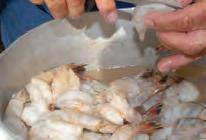

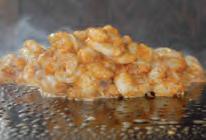





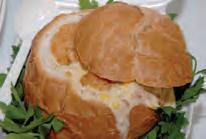

Beginning July 11th - July 13th
THEATRE
TULANE SHAKESPEARE FESTIVAL
New Orleans, Louisiana
Founded in 1993 by a handful of Tulane faculty members, the New Orleans Shakespeare Festival at Tulane has become one of the most significant theatre events in the Gulf South. Throughout July, the festival will mount a more traditional Shakespearian performance of Julius Caesar. Preview performance will be July 11, and opening night on July 12—with performances Thursdays–Sundays through July 21 (7:30 pm Thursday–Saturday; 1:30 pm Saturday–Sunday).
$40. The festival also features a July 17 one-night-only performance by the improv group The Fools Ensemble, who will present A Very Important Play their take on a "Shakespeare" play that has never been put to the stage before (and never will again). 7:30 pm. $25. All events will take place in Tulane's Lupin Theater. neworleansshakespeare.org. 1


ART EXHIBIT
CHERISHED: THE ART OF CLEMENTINE HUNTER
Baton Rouge, Louisiana
Perhaps Louisiana's most renowned artist, folk painter Clementine Hunter's work will be displayed at the LSU Museum of Art in a solo exhibition for the first time since 1971, when Hunter was in her eighties. With forty pieces on view, visitors will experience the scope of Hunter's output,
including paintings that she created at Melrose Plantation, where Hunter was born in 1886. A self-taught artist, Hunter's vividly painted work captures the small moments, rituals, and surroundings that made up daily plantation life. The show will include oral histories from Hunter's family members, exploring memory as it is passed between generations. lsumoa.org. 1
JUL 12th
GARDENING
TROPICAL GARDENING WORKSHOP
Albany, Louisiana
It's hot and humid out there … might as well make the most of it. Come to this

workshop at the Albany-Springfield Branch Library to learn how to create a tropical oasis with tips and insights from a certified Master Gardener. 1 pm. Free. mylpl.info. 1
JUL 12th
FUNDRAISER
SOUTHERN NIGHTS SOIRÉE
Mandeville, Louisiana
The St. Tammany Chamber of Commerce's biggest fundraiser of the year brings casino games, an open bar, samples from area fine dining restaurants, and both live and silent auctions—all at the Greystone Event Center in Mandeville. Proceeds from the event— an opportunity to network with business leaders from across St. Tammany Parish— enable the chamber to offer members relevant programs and services at reasonable prices. 7 pm–10 pm at 935 Clausel Street. $150; $250 per couple, $1,000 for ten tickets. sttammanychamber.org. 1
JUL 12th
LIVE MUSIC THAT '70S BAND AT THE MANSHIP
Baton Rouge, Louisiana
The nine-piece band brings the seventies back with full renditions of pop classics, from Aretha Franklin to Chicago, Elton John, Donna Summer, and more. 7:30 pm. $25. manshiptheater.org. 1


JUL 12th - JUL 14th
BEWARE THE BATS
SAN FERMIN: NOLA RUNNING OF THE BULLS
New Orleans, Louisiana
The popular fiesta is modeled after the San Fermín festival and its running of the (actual) bulls in Pamplona, Spain. But releasing raging bulls through the streets of the French Quarter would be copying, so local organizers went for bat-wielding roller derby girls instead. Resplendent in horned helmets and armed with whiffle ball bats, the Big Easy Rollergirls unleash their fury on any slow-moving stragglers. "Bulls" are released at 6:30 am, and go until noon. This year's expanded slate of events will call Gallier Hall headquarters, and will include a El Txupinazo pre-party Friday night from 6 pm–9 pm with live music and other entertainment, La Fiesta de Pantalones on Saturday after the race, and an El Pobre de Mi (Poor Me) Burlesque Brunch Sunday morning. Details at nolabulls.com. 1
JUL 12th - JUL 21st
THEATRE
"BEAUTY AND THE BEAST" AT THE IBERIA PERFORMING ARTS LEAGUE
New Iberia, Louisiana
A tale as old as time is coming to The Iberia Performing Arts League. The young
thespians of Iberia present Beauty and the Beast. While belting classic songs from the Disney film, be transported to a land of spells, adventure, and dancing dinner candelabras. 7 pm Thursdays–Saturdays; 2 pm Sundays. $17. ipaltheater.com. 1
JUL 12th - JUL 26th
KID STUFF
BREC SUMMER MOVIE SERIES
AT LIBERTY LAGOON
Baton Rouge, Louisiana
Get your inner tubes ready—this summer, BREC will put on a movie series at the Liberty Lagoon Waterpark. Watch a movie on the big screen while floating along the lazy river or hanging out on the lawn. Enjoy food trucks, photo ops, and character meet-andgreets throughout the event.
July 12: The Little Mermaid
July 26: Ruby Gillman: Teenage Kraken
7:30 pm–9:30 pm. All ages, but guests under 13 must be accompanied by an adult. $10. brec.org. 1
VISUAL ART
CASEY JOINER PHOTOGRAPHY
AT SIBYL GALLERY
New Orleans, Louisiana
Louisiana native Casey Joiner presents Surrounded by Natural Causes at Sibyl


Gallery, a recent addition to the New Orleans Uptown arts scene. In this collection, Joiner investigates the aftermath of her father's death in 2023, after which details became haunting specimens of loss and memory. Joiner says her work "is informed by her affection for places full of peculiar nonsense and deep struggle, slow things, long standing traditions, and growing up in the Deep South."
Opening reception July 12 from 5 pm–8 pm. Gallery hours are Saturday and Sunday from noon–6 pm or by appointment. sibylgallery.com. 1
JUL 13th
EYEBROWS
FRIDA FEST
Bay St. Louis, Mississippi
Each year, Bay St. Louis celebrates the life and work of Mexican surrealist painter Frida Kahlo. Known for her unrepentant unibrow, turbulent marriage to muralist Diego Rivera, and haunting, allegorical self-portraits, Kahlo has become one of Mexico's most revered and well-known artists. The folks behind the boisterous Dolly Should birthday celebration of Dolly Parton's birthday bring you this zesty street party, complete with a Frida

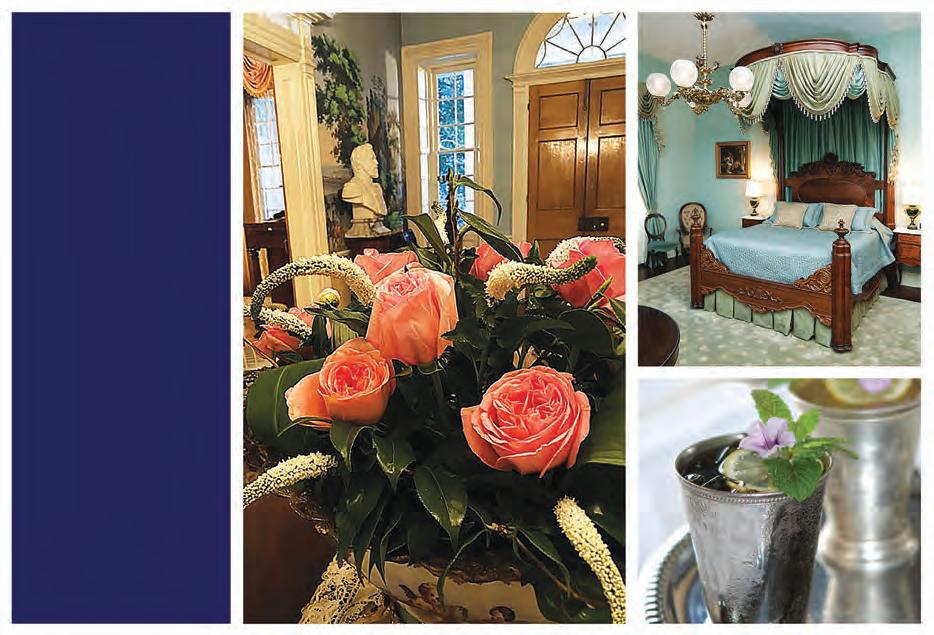



Beginning July 13th
look-alike contest. Fill in your eyebrows and enjoy the fun. Free. 8 am–8 pm at the Mockingbird Cafe. gulfcoast.org. 1
JUL 13th
SHOP TIL YOU DROP
SHOP ST. DENIS FEST
Natchitoches, Louisiana
Louisiana's oldest settlement proves it knows how to party during Shop St. Denis Fest—a block party featuring live music, food trucks, and local vendors. 10 am–5 pm. Free. natchitoches.com. 1
JUL 13th
HISTORY & HERITAGE EXPLORATIONS IN GENEALOGY: "STREWN ACROSS THE SEAS: THE ACADIAN DEPORTATIONS, 1755-1763"
Port Allen, Louisiana
The West Baton Rouge Museum will host a genealogy lecture led by guest speaker R. Martin Guidry at the Port Allen Branch of the West Baton Rouge Library on the subject of Acadian lineage. Guidry is a well-known authority on Acadian history of over fifty years, and is even a
Living Legend of the Acadian Museum in Erath, Louisiana. His research involves original civil and ecclesiastical records from the 1600s through the present day. 10:30 am–noon. Free. westbatonrougemuseum.org. 1
JUL 13th
GARDENING
GARDEN DISCOVERIES AT EBRP MAIN LIBRARY
Baton Rouge, Louisiana
Garden pests terrorizing your tomatoes? Not sure what blight is attacking your fig trees? Stop by for a workshop on "Pest Control Strategies for Home and Garden" at the East Baton Rouge Main Library. Dr. Aaron Ashbrook, an Urban Entomologist, will lead the educational event as part of The Baton Rouge Botanic Garden Foundation's free "Garden Discoveries" series. Participants learn about insect biology, physiology and behavior, and how better understanding our garden fiends (or friends!) can help mitigate their impact on our crops. 10 am. Free. Register at ebrpl.co/calendar, or by calling 225-231-3750. 1
JUL 13th
HOT WHEELS
BAYOU MOTOR FEST
Baton Rouge, Louisiana
Start your engines! The Bayou Motor Fest returns to the Raising Canes River Center Arena, featuring glittering automobiles ranging from classic cars, muscle cars, trucks, hot rods, and more. After the show, the Kenny Wayne Shepherd Band will rock the River Center Theater. Noon–6 pm. $20; event parking $10; concert tickets are $42–$162. raisingcanesrivercenter.com. 1
JUL 13th
FLEET FEET
NORTHSHORE CAJUN DANCE AT ABITA TOWN HALL
Abita Springs, Louisiana
As the temperature outside soars, the Northshore Cajun Dancers Club's mission to promote the music and dancing of the Cajun people keeps its cool. Since 1991 this group has met monthly to share the community and rhythm of zydeco and Cajun music, with a live band and free dance lessons to boot. Dance lessons take place from 7 pm to 7:30 pm, with live music from 7:30 pm–10 pm—all at the Abita Springs Town Hall, 22161 Level Street. $12 for age 18 and up ($10 for members of Northshore Cajun Dancers Club). Free for kids 12 and under.
louisiananorthshore.com 1
JUL 13th
SHOP ‘TIL YOU DROP
SIZZLING CHRISTMAS IN JULY ARTS & CRAFTS SHOW
Mandeville, Louisiana
Santa should probably choose to leave the big woolen hat and coat in the sleigh for this event, which promises attendees a mid-summer chance to get a head-start on their fall and Christmas shopping. Expect a wide array of local and regional artisans selling handmade arts, crafts, and clothing from 9 am–4 pm at the Mandeville Lion's Club, 720 Lafitte Street. More info on Facebook at the Sizzling Christmas in July Arts & Crafts Show event. 1
JUL 13th
ARTS & CRAFTS PRESSED FLOWER ART WORKSHOP
New Orleans, Louisiana
This signature garden workshop at Longue Vue House and Gardens welcomes a horticulturalist expert to teach new ways to interact with the flora and fauna of the garden. 2 pm–3:30 pm. $85; $75 for members; $35 for children twelve and older. All supplies and light refreshments are included. longuevue.com. 1


JUL 13th
FILM
INDY FILM FESTIVAL AT THE INDEPENDENCE PARK THEATER
Baton Rouge, Louisiana
Support the young moviemakers of Greater Baton Rouge at the inaugural INDY Film Festival at Independence Park Theater, which will showcase talent from IPT Film Camps and affiliate programs. Come for eclectic programming and stay to see who wins the awards for short film, feature film, and podcast. Doors 10 am,
film showcase 11 am. $10. theparktheatre.com/events/indy-fest. 1
JUL 13th - JUL 27th
THEATRE
THE DINNER DETECTIVE COMEDY MYSTERY DINNER SHOW
Baton Rouge, Louisiana
America’s largest interactive comedy murder mystery dinner theatre show has landed in Baton Rouge. Audiences help solve a hilarious mystery while
feasting on a four-course dinner. Just beware! The culprit is hiding in plain sight somewhere in the room. You might even even discover yourself to be the prime suspect. 6 pm–9 pm at the Holiday Inn (4848 Constitution Avenue). $60. thedinnerdetective.com. 1
13th - JUL 28th
THEATRE
GILBERT & SULLIVAN'S "PIRATES OF PENZANCE"
Covington, Louisiana
Young Frederic sets sail on his quest to win the heart of a particular maiden under the watchful tutelage of a few salty pirates and one questionable nursemaid in Gilbert and Sullivan's beloved coming-of-age comedy, which is filled with recognizable tunes like "I Am A Pirate King" and "Modern Major General." Playmakers Theater of Covington's production of the musical theatre classic is directed by Jennifer Patterson. Performances at 7 pm Saturdays and 2 pm Sundays at 19106 Playmakers Road. playmakersinc.com. 1
JUL 13th - AUG 24th
ART EXHIBIT
SUMMER CONTEMPORARY EXHIBITION: WILD
Baton Rouge, Louisiana
"Wild Thoughts. Wild Actions. Wild Places. Wild Beings."—such is the
prompt for the open call Summer Contemporary Exhibition at the LSU School of Art's Glassell Gallery. Selected work will cover a range of modalities and interpretations. New Orleans-based artist Ron Bechet is this year's judge, and awards will be announced at the closing reception on August 24, from 6 pm–8 pm. Free and open to the public. glassellgallery.org.1
ART EXHIBIT
BERNARD MATTOX AT CHRISTWOOD ATRIUM GALLERY
Covington, Louisiana
Bernard Mattox's work is archeological in spirit, a menagerie of symbols and objects that evoke a sense of excavation. The Kantian Bridge Works—Chapter 2 , his new show on exhibit at Christwood Atrium Gallery in Covington, engages the teachings of German philosopher Immanuel Kant to explore "the relationship between subject/object or self/not self." Mattox, who grew up on Bayou Falaya and New Orleans, draws from the psyches of nature and city, creating hieroglyph-esque collages of imagery. There will be an opening reception on July 13 from 4:30 pm–6:30 pm. The gallery is open Monday–Friday 9 am–5 pm. Free. Details at facebook.com/theatriumgallery. 1



LITERATI AN AFTERNOON WITH AUTHOR RANNAH GRAY
Baton Rouge, Louisiana
Familiar Evil, Rannah Gray's debut book, follows the true story of Baton Rouge TV personality Scott Rogers, who flees after being exposed as a child predator. Gray unexpectedly teams up with a classmate of one of Rogers' victims to expose Rogers for who he really is. Her conviction to tell the truth propels this book from Louisiana to London and back again. Join Gray, one of Louisiana's top media consultants and author of two mystery novels for young readers, in a discussion and signing of her award-winning book at at the East Baton Rouge Parish Main Branch Library. 3 pm in the first floor conference room. $30; $20 Senior Citizens; $10 Students (with I.D.). ebrpl.com. 1
VIVE LA FRANCE!
BASTILLE DAY MASS AT ST. JOSEPH'S
Baton Rouge, Louisiana
Each July 14, Baton Rouge celebrates the Fête nationale française, or French day of Independence, with a Mass at downtown Baton Rouge's St. Joseph Cathedral. This special Sunday service will include a thirty-minute concert of French organ music featuring David Summers and John Paul Chauvin performing works by Eugene Gigout, César Franck, and Louis Vierne. Cantor Andy Plaisance will present the beautiful Cantique de Jean Racine by Gabriel Fauré. After Father Michael David's homily, a reception will follow in the Parish Hall. 10:30 am at 412 North Street in downtown Baton Rouge, and televised on Cox channel 15. See Facebook at the Friends of Bastille Day Baton Rouge page. 1
CROONERS
SYMONE FRENCH AT THE LOBBY LOUNGE
Slidell, Louisiana
Come to the Northshore Harbor Center's Lobby Lounge to find out what you get when you mix a little bit of heartache, with a splash of Jameson and a healthy dose of soul: Symone French. Born and raised in Mobile, Alabama, where she was influenced by her parents' musical tastes, the backing track to Symone's upbringing was an eclectic blend of Steely Dan, Hall & Oats and Bonnie Raitt (from her father); with lasting soul influences thanks to her mother's love for the music
of Teena Marie, Donna Summer, and Prince. Those influences cultivated the sound that audiences across the Gulf Coast flock to French's performances to hear. French takes the stage at Harbor Center's Lobby Lounge from 7 pm. 100 Harbor Center Boulevard. $20 general admission, reserved tables seating two or four are $50 and $100, respectively. harborcenter.org. 1
SLEIGHT OF HAND
CRESCENT CIRCUS AT LIVINGSTON LIBRARY
Livingston, Louisiana
Magic meets circus arts in a stunning display of onstage performance, right at your local library. The Crescent Circus
Pavilion this summer. The three-day festival celebrates Grand Isle's ongoing recovery from Hurricane Ida. Enjoy food, craft booths, and other local vendors—plus performances by Junior Lacrosse, Ryan Foret & Foret Tradition, Clay Cormier & The Highway Boys, and many more. Thursday 4 pm–11 pm. Friday noon–11 pm. Saturday 11 am–11 pm. $30 for weekend bracelet. $10 for Thursday's events. $15 for Friday and Saturday. 12 and younger are free. islandstrongmusicfest.com. 1
THEATRE
"A STREETCAR NAMED DESIRE" AT THE MARIGNY OPERA
New Orleans, Louisiana
Tennessee Williams' landmark Pulitzer Prize-winning drama arrives at the Marigny Opera House, performed by the Tennessee Williams Theatre Company of New Orleans. When Mississippi belle

is made up of husband-wife duo Nathan Kepner and Morgan Tsu-Raun, who deliver a one-of-a-kind performance that has earned six international titles, performances at London's prestigious Magic Circle Theater, and an appearance on The Tonight Show. Here's the schedule:
July 16: 10 am at Albany-Springfield Branch and 2 pm at South Branch
July 17: 10 am and 2 pm at Denham Springs-Walker Branch
July 18: 10 am at Watson Branch and 2 pm at Main Branch Free. myapl.org . 1
JUL 18th - JUL 20th
FEST FOR THE COAST
ISLAND STRONG MUSIC FEST Grand Isle, Louisiana
The third annual Island Strong Music Fest returns to the Tarpon Rodeo
though those are up to you. So pack up your favorite libations, and open your mind to the history of our community. This month features an energetic summer concert performance by Louisiana alt blues/rock band Blue Crab Redemption—which draws from influences the likes of Jimi Hendrix, Stevie Wonder, and The Eagles. 6 pm–8 pm. Free. westbatonrougemuseum.com. 1
LIVE MUSIC
THE PRODUCERS LIVE AT MID CITY BALLROOM
Baton Rouge, Louisiana
Back by popular demand, power pop/New Wave band The Producers will travel back from Atlanta to perform at Baton Rouge's Mid City Ballroom again for one night only. 8 pm. $45 in advance at bontempstix. com. Mid City Ballroom is BYOB. midcityballroom.com. 1
HISTORICAL EXHIBITION
CAPTIVE STATE: LOUISIANA AND THE MAKING OF MASS INCARCERATION
New Orleans, Louisiana
Louisiana’s present-day distinction as the world’s incarceration capital is rooted in three centuries of history. Throughout this history, people in power have used systems of enslavement and incarceration to hold others captive for punishment, control, and exploitation—disproportionately affecting Black Louisianans. Through historical objects, textual interpretation, multimedia, and data visualization, the Historic New Orleans Collection's newest exhibition, Captive State: Louisiana and the Making of Mass Incarceration, investigates these throughlines and arrives at an irrefutable truth: that the institutions of slavery and mass incarceration are historically linked. Captive State tells this story in two parts.
Blanche DuBois arrives at her sister's French Quarter apartment with nowhere else to go, she clashes with her hard-edged brother-in-law Stanley Kowalski. Secrets, sensuality, and big reveals shake up the two-room New Orleans flat. Will Blanche be able to start her new life in the Big Easy, or will she be crushed by something brutal and hard? 7:30 pm. $40; $30 under 25 (with ID), $10 Loyola University students. twtheatrenola.com. 1
JUL 19th
LIVE MUSIC
HISTORICAL HAPPY HOUR: BLUE CRAB REDEMPTION
Port Allen, Louisiana
For its regular Historical Happy Hour events, the West Baton Rouge Museum hosts local musicians and storytellers, featuring intellectual discussions, music, panels, speakers, and—of course—drinks,
The first outlines how Louisiana’s colonial and early American governments created race-based systems of oppression through legislation, policing, imprisonment, and violence that matured as New Orleans became the hub of the domestic slave trade. The second part traces how the Louisiana Constitution of 1898 enabled an era of mass incarceration in the twentieth and twentyfirst centuries. The exhibition concludes with a reflection, reading recommendations, and information on ways to get involved on issues related to mass incarceration. Tuesdays–Saturdays, 9:30 am–4:40 pm, Sundays 10:30 am–4:30 pm. hnoc.org. 1
JUL 20th
OL’ BLUE EYES
SALUTE TO SINATRA AND THE LEGENDS OF SONG
Baton Rouge, Louisiana
Don't miss Ned Fasullo & The Fabulous

Big Band Orchestra's celebration of the one, the only Frank Sinatra at LSU Union Theater this month. "A Salute to Sinatra and The Legends of Song" will feature the greatest hits by the biggest jazz & big band singers of yesteryear— Frank Sinatra, Dean Martin, Bobby Darin, Nat King Cole, Peggy Lee, Ella Fitzgerald and more. Ned Fasullo and His Fabulous seventeen-piece Big Band Orchestra will be center-stage, with a few surprise special guests bound to join the party. A portion of this event's proceeds will benefit The Baton Rouge Zoo Foundation. 7 pm on Tower Drive on the LSU campus. $35. bontempstix.com. 1
JUL 20th
BOOT-SCOOTIN’
GRAND COUNTRY JUNCTION AT SUMA HALL
Livingston, Louisiana
Livingston's most happenin' live music event returns to Suma Hall, with American Heritage Night featuring Ashton Gill and The Journeys. Come through downtown Livingston for a night of country music. Doors open at 5:30
pm. Show starts at 7:00 pm. $15; $10 for ages 4–12, Children 3 and under are free. grandcountryjunction.com. 1
20th
KOKOMO STROLL
Covington, Louisiana
Break out your flip-flops and coconut bras, because island living is coming to the Northshore. In the spirit of summer, the Kokomo Stroll is Covington's leisurely, long-running walk through the historic downtown neighborhood, while more than twenty participating restaurants and local businesses provide samples of signature bites and refreshing specialty drinks and craft beer, with live music carefully selected to complement the summer vibe. If you partake in every cocktail sample, you might actually believe you're on vacation. Attire is "dress down" … think beach casual. 6 pm–9 pm, rain or shine. Must be over 21 to attend. Your specialty cup serves as the price of admission and will need to be purchased prior to the event. Buy cups at kokomostroll.com. 1

Slidell, Louisiana
If you like your pets on the conversation-starting side, consider the possibilities among the thousands of reptiles, amphibians, and unfamiliar aquatic beasts assembled at the Herps Exotic Reptile & Pet Show. The largest reptile and exotic pet show in Louisiana slithers into Slidell's Harbor Center this weekend, promising thousands of reptiles, amphibians, and invertebrates
to meet, greet, and, perhaps, to take home with you. If you're not sure, this show also incorporates a large educational section, at which attendees can come nose-to-(insert relevant appendage here) with representatives of various distantly related branches of the animal kingdom. 10 am–5 pm Saturday, 10 am–4 pm Sunday at 100 Harbor Center Boulevard. Day pass: $10 for adults, $5 for children ages 5–12; and free for children 4 and younger. Twoday pass: $15 for adults, $8 for children ages 5–12, and free for children 4 and younger. herpshow.net. 1





BLUES FEST
2024 SUMMERTIME BLUES BENEFIT AT THE TEXAS CLUB
Baton Rouge, Louisiana
The Baton Rouge Blues Society is proud to present the 2024 Summertime Blues Benefit, which will get things rocking and rolling at The Texas Club. Expect local heavyweights like Lil Ray Neal Band, Chris Leblanc Band, Eddie Smith Band, Hanna PK Band, and special guest Big Luther Kent. A ticket includes jambalaya, white beans, and other such culinary delights, as well as a year's membership to the Baton Rouge Blues Society. Doors 2:30 pm, food and live music from 3 pm. $180 reserved tables for four. Contact Ken by phone/text at (225) 572-3081 to reserve. $25 general admission advance, $30 door. For GA tickets, contact: Ken, Dusty (225) 328-3167, Jason (225) 304-3826, or the Texas Club. texasclub.com. 1
TIPPLES
TALES OF THE COCKTAIL
New Orleans, Louisiana
The enthusiastically received annual event that celebrates cocktail culture in New Orleans and around the world is back. Celebrated chefs, authors,
bartenders, and cocktail experts guide festival-goers through a very-welllubricated week's worth of seminars, cocktail tours, superstar mixologist lectures, cooking and cocktail-mixing demonstrations, tasting room tours, Spirited Dinner pairings, and cocktail parties. There are, literally, dozens of events to choose from. Tickets go fast for some of the more popular events, so get in while the getting's good. Many events happen at the Hotel Monteleone, but a handful take place at spirit-savvy bars, restaurants, and other locations in the city. Find all the details at talesofthecocktail.com. 1
CHRISTMAS IN JULY CARD PARTY
Port Allen, Louisiana
Channel your holiday spirit (and all the cool air it brings) and spend the day with the West Baton Rouge Museum for its annual Christmas in July fundraising event. Taking place next door to the museum in the Port Allen Community Center, the event will start strong with a complimentary morning cocktail and carry forth with games, door prizes, lunch, raffles, and more. 10 am–3 pm. $30, must be paid in advance by July 8. (225)-336-2422. wbrmuseum.org. 1
JUL 24th
ART WALK
SUMMERTIME SUPPER STROLL IN BATON ROUGE
Baton Rouge, Louisiana
Combine your evening walk with a selection of local eats at this collaboration between Elizabethan Gallery, Reginelli's Pizza, Jed's Local, and Red Stick Spice Company. Convene at Elizabethan for a tipple and nibble, then mosey over to Reginelli's for apps and sips. Jed's will provide a Creole main dish and Red Stick Spice Company will close out the evening with dessert and a premium tea. Meet the chefs and owners of your favorite local businesses and enjoy that Mid City vibe. 6 pm–9 pm. $85. Details on the Summertime Supper Stroll Facebook Event. 1
FOOD FEST
13TH ANNUAL BAYOU BBQ
BASH IN MORGAN CITY
Morgan City, Louisiana
Slow and steady wins the race in this International Barbecue Cookers Association competition that sets the area beneath the Highway 90 bridge to smoking. Competitors should come armed with their homemade rubs and marinades—and a thirst to prove themselves. (An appetite will come in handy, too.) Categories include pork spare ribs, brisket, and chicken. In
addition to competitive cooking events for corporations, teams, and kids, Saturday offers chances to devour tasty things from highly regarded barbecue vendors, booths for arts & crafts, live music in the evenings, and on and on. Festivities start with a kickoff party; live music, crafts, and vendors start Friday at 4:30 pm; and the festival kicks into full gear on Saturday from 10 am, under the Highway 90 bridge in Morgan City. cajuncoast.com. 1
JUL 26th
MAKE IT UP AS YOU GO ALONG FAMILY DINNER IMPROV COMEDY SHOW
Baton Rouge, Louisiana
From the folks who brought us Spoof Night! with Films at Manship comes a locally made, monthly Improv Comedy Show. Hang out with Baton Rouge's premier comedy troupe for some live, interactive improv games. 7:30 pm. $14. manshiptheatre.org. 1
JUL 26th - JUL 27th
FOOD FEST
NATCHEZ FOOD & WINE FESTIVAL
Natchez, Mississippi
One of the most highly-anticipated culinary events in Mississippi, the Natchez Food & Wine Festival attracts top chefs and restaurateurs from across the Gulf South.



Each summer, they come to the city on the bluffs to stage multiple-course dinners in historic mansions, progressive dining events, gourmet tastings, and casual social occasions that make the most of the city's spectacular riverside setting. Things begin Friday with the traditional (and huge) "Tastings Along the Mississippi River" taster's fair, which brings scores of regional chefs, restaurants, and wine and beer purveyors to the Natchez Convention Center. The feast continues through Saturday evening, when the Invitation to the Natchez Table dinners bring top regional chefs to stage elaborate feasts in grand Natchez mansions. Other events on the agenda this year include:
• Mixology classes at Smoot's Grocery (11 am & 2 pm Saturday)
• A Cookbook Author Progressive Luncheon visiting several downtown Natchez businesses (various times Saturday)
• A Wine & Cheese Tasting at The Castle Restaurant on the grounds of Dunleith Historic Inn (1:30 pm Saturday)
• Cooking Demonstrations at Church Hill Variety by chefs Tori Loomis, Taylor Bowen Ricketts, and Cory Bahr (3 pm–5 pm Saturday)
• The traditional Brats, Beer and Bocce event at Natchez Brewing Co. (5 pm–7 pm Saturday)
• A casual Summer Camp Dinner at Church Hill Variety (6 pm Saturday)
And this year the festival's signature Invitation to the Natchez Table Wine Dinners bring multi-course menus by visiting chefs and winemakers to two unique downtown Natchez venues (7 pm Saturday):
• A Food is Art Dinner at Conde Contemporary Art Gallery with chefs Karen Carrier, Phillip Lopez, David Leathers and Molly Manning Robertson
• Coquerel Wines Winemaker Dinner at The Briars with chefs Cooper Miller and Mitch McCammey.
Details for individual events and tickets at natchezfoodandwine.com. 1
DANCE
MONTHLY CONTRA DANCE
Baton Rouge, Louisiana
Contra dance has been around since the American Revolution—it's similar to square dancing, with simple, fun steps performed in a line that flows in different directions so that everyone has an opportunity to dance with new partners. Each month, a dance is held at Common Hall in St. Alban's
Chapel on LSU's campus, accompanied by live music and a caller explaining the steps to the dance. Couples and singles are welcome, as partners change for each dance. Newcomer orientation begins at 3:45 pm, and the dance is from 4 pm–6:30 pm. Wear comfortable shoes with smooth soles and loose clothing, and bring water. $7 per person per class, free for first-timers. louisianacontrasandsquares.com. 1
JUL 27th
VISUAL ARTS
ARTS FOR EVERYBODY IN BATON ROUGE
Baton Rouge, Louisiana
Baton Rouge will be one of a number of cities around the country participating in Arts for Everybody, a national campaign from One Nation/One Project that aims to promote art as an essential component of personal well-being and strong communities. For the occasion, the Arts Council of Greater Baton Rouge is collaborating with One Nation/One Project, National League of Cities, and the City of Baton Rouge to present art-making and health initiatives around the concept of "No Place Like Home." Artists across genres will be engaging with the community around the theme, culminating in a presentation and performance at the Cary Saurage Community Arts Center. Noon–6 pm. artsbr.org. 1
JUL 27th
KIDSTUFF
CHILDREN’S DRAWING AND PAINTING WORKSHOP
Port Allen, Louisiana
Bring the wee ones to the West Baton Rouge Museum to join Shauna Landry, an expert in children’s art education, for a drawing and painting workshop designed to develop artistic skills. All materials included. 10:30 am–noon. Free. To register, call (225) 336-2422. westbatonrougemuseum.org. 1
For all our July events, including the gobs we couldn’t fit in print, point your phone camera here or visit countryroadsmag. com/events-and-festivals.

Opelousas, a larger-than-life legend connects Louisiana’s past, present,
It’s the early 1800s. Thomas Jefferson has just purchased the Louisiana territory from France, France is on the verge of war with the British, and the spirit of expansion swells the hearts of the American people. One of them—an ambitious fellow—sits propped against the sturdy trunk of a live oak tree, sharpening his knife and considering the possibilities of tomorrow. This same oak tree, now over 350 years old, still stands in the city of Opelousas, and aptly bears the name of the larger-than-life frontiersman who once sat in its shade. Ladies and gentlemen: meet the Jim Bowie Oak.
Long before his infamous death at the Battle of the Alamo, Jim Bowie made a name for himself throughout Louisiana, where he spent most of his
years. The rough-and-tumble life of the Louisiana frontier honed his talents for hunting, trapping, and entrepreneurship, and it was here he first exhibited the daring and tenacity that would come to define his legacy. Whether wrangling alligators on the Ouachita River, dueling a sheriff on a sandbar in the Mississippi, buccaneering with the pirate Jean Lafitte, or operating his family sawmill in Avoyelles Parish, Jim Bowie’s time in Louisiana cemented his reputation as a man of considerable ambition and enterprising nature.
Although much of Bowie’s life is shrouded in myth, his fighting prowess in the battles of the Texas Revolution solidified his legacy. Bowie’s spirit of survival mirrors that of the oak tree which

bears his name; its presence serves as a testament to perseverance and rugged determination. The roots of the Jim Bowie Oak are sunk deep into the soil of Louisiana’s history, growing with our nation, weathering its own battles, and standing as an enduring symbol of strength.
Preserving the Jim Bowie Oak is about more than conserving a venerable tree; it’s also about honoring the stories it embodies. By protecting and nurturing our heritage live oaks, we honor the legacy of the events and the people who shaped our world, providing a connection to the past, and inspiration for future generations. To linger in the shadows of a tree such as the Jim Bowie Oak is to stand in the shade of time.

By Jordan LaHaye Fontenot

“French is in people’s blood here.”
Chef Will Baxter told me this, sitting in the dining room of his restaurant, Jane’s French Cuisine, in Lafayette. Indeed, Baxter’s grandmother, the antiquarian Jane Fleniken, designed the very building Jane’s occupies in the style of a rural French cottage, adorning its interior with French art and cabinetry. Jane’s, with its coursed menu featuring foie gras and rabbit loin, might be described as a testament to America’s long-held infatuation with French culinary culture. But in Louisiana, of course, it’s more than infatuation.
For this year’s Cuisine Issue, we are featuring three Parisian-style French restaurants here in Louisiana, each operating beyond the culinary epicenter of New Orleans. The Crescent City, of course, is home to some of the oldest, most important, and most innovative French-influenced restaurants in the world (Antoine’s, Arnaud’s, Dooky Chase’s, Justine, N7 to name a few). And
across Louisiana, one encounters the Francophone Cajun and Creole cultures’ culinary delights—often with French accents in their names. But in Baton Rouge, Lafayette, and even Marksville— some Louisiana chefs have reached back deep into our culinary DNA to present something simultaneously familiar and foreign: Parisian-style cuisine.
So before sending you to sup in these outposts of the City of Light, let’s take a moment to explore the integral rela tionship between Louisiana cuisine and French cuisine, a long and entangled history that goes back to the day in 1682 when LaSalle dubbed the Mississippi River Basin La Louisiane for King Louis XIV. This was to be the “New France”.
The first European settlers of the re gion, who arrived in the early eighteenth century from France and French Canada, brought with them the ideals of the En lightenment. “There, people were start ing to see food as an art form,” said Liz Williams, founder of the Southern Food & Beverage Museum and the Nation

tinguished them from English settlers ingled to survive in the New World because of their resistance to any ingredient or lifestyle that was not “English”. “The French perspective did not believe thisisiana was an extension of France. So, if you have to eat an alligator, it is now a ‘French’ alligator.” Depending upon the knowledge of the Native peoples in the region, the French learned how to harvest the riches of this new land—the game, the oysters, the pecans. “And now, it’s a
In this way, the Indigenous people’s centuries-old culinary traditions—which-
tive dishes and techniques are culturally perceived as Cajun or Creole dishes, with French-sounding names. “Think about maque-choux,” said Williams. “It’s made with corn. I mean, this is something the

Native people ate. And the French see what they’re making, and they add cream to it. And if you look at maque-choux, it’s spelled in a French way. But ‘maque-choux’ doesn’t mean anything in French.” Most likely, the name came from the French interpretation, and phonetic spelling, of the words the Natives used to describe the dish. “The French were good at branding,” said Palmer.
After the original French settlers arrived in Louisiana, the state became a destination for immigrants from across the French diaspora. The Germans (mostly from French-speaking regions on France’s border) arrived in the early eighteenth century, followed some decades later by the Acadian refugees of the Grand Dérangement in Nova Scotia, who would come to be called the Cajuns. Both of these groups would bring distinct culinary traditions, interpreted through Louisiana’s resources and already influenced in some part by France, to the cultural landscape of the region.
At the same time, the new colonists’ demand for free labor resulted in a population of enslaved Africans that eventually outnumbered the European settlers. Most of the African people forcibly brought to Louisiana came from the Senegambia region of West Africa, which had been colonized by the French beginning in 1659. “French Creolization happened even way before Louisiana,” said Palmer. “It started in Africa in places like Senegal, before Africans were brought in bondage to the New World. The mixing of cultures had already happened in Africa at its port cities.” Most of the food prepared for European settlers in early Louisiana were prepared by African cooks, whose hands held layers of influence from traditional African cuisines and French-influenced African cuisines, now using Louisiana’s Indigenous ingredients and techniques to prepare food that reminded French settlers of their European home.
I spoke with Palmer a few days after she attended the June 10 announcement of this year’s James Beard Foundation Awards, which dubbed New Orleans’s Chef Serigne Mbaye and Effie Richardson’s Senegalese restaurant Dakar NOLA as Best New Restaurant. During the ceremony, Mbaye had said, “Think about Southern food without West African influence. What would you really have?” His win and the success of Dakar NOLA, Palmer said, are indicative of a current renaissance of Creole cuisine reflecting on, and celebrating, its Senegalese origins. “When you think about Senegal, it is the foundation of so many dishes—jollof rice, you think about jambalaya,” said Palmer. “So many ‘French’ dishes we love so much, they came from Senegal.”
By the end of the eighteenth century, France had debuted the concept of the ‘restaurant’ for the first time—evolving out of establishments that served bouillon, calling themselves “bouillon restaurants,” which translates to “restorative
broth”. When these Enlightenment-era shops started using menus, more offerings joined the broth—offering diners a selection, rather than the take-whatwe’ve-got approach of taverns at the time. This led directly to the creation of the first fine dining restaurants in Paris such as La Grande Taverne de Londres and Trois Frères. “The restaurant became where you wanted to be seen, where you had your own Versailles,” said Palmer. “It was still for the upper class, but now you didn’t have to wait for the king or queen to invite you to the palace.”
The trend quickly caught on in America, and especially in Louisiana where the pulse of French culture beat strongly. “We’re still thinking French, speaking French at this time,” said Williams. “People are buying journals and newspapers and books being sent over from Paris. When absinthe became all the rage there, it became all the rage in New Orleans, as [eventually] did the restaurant.” In 1840, the Italian Antoine Alciatore—who had spent his childhood in France, and received culinary training with premier French chefs (it is believed that he was present when soufflé potatoes were created)—came to New Orleans to open one of the city’s first restaurants, Antoine’s. Still in business today, Antoine's set the standard for French-Creole fine dining, which would come to define the city’s now internationally-renowned restaurant scene.
Across Louisiana today, the layers of these many influences present themselves in our fine dining establishments, our grandmother’s kitchens, and our diners and gas stations, too. The ingredients of this ecosystem we call home come together in combinations shaped by the traditions of its native peoples, the cultural memory of the African diaspora, the artistry of the French and their vice-like grip on their identity, and the influence of the dozens more cultures who came to call this place home—as well as the in novative evolutions of time itself. “That’s the beauty of our culture,” said Palmer. “It’s all the people that built this amazing cuisine.” •










Story by Elizabeth C. Weinstein • Photos Lucie Monk Carter

Maison Lacour is the only “true” French restaurant in Baton Rouge. The family-run establishment has been serving classic French cuisine in a petite house on North Harrell’s Ferry Road for nearly forty years. While traditional French dishes are on the menus of such grand dames as An-
toine’s, Galatoire’s, and Arnaud’s, even these bear the heavy influence of Louisiana’s regionally-specific Creole and Cajun cuisines. Maison Lacour is one of the few institutions in the state to distinguish itself with a veritable Parisian French menu.
On my recent visit, proprietor Eva Jetty greeted me and my husband with

her usual “Bonsoir,” pronounced in her endearing French accent as she ushered us to our table. There are three dining rooms in the quaint farmhouse. Ours had a fireplace. Imbued with rustic charm, the rooms are arranged with intimacy in mind and decorated with lattice-back French country chairs, assorted knickknacks, and posters collected by Eva on the couple’s trips to Paris. French music compliments the mood.
Eva suggested that we begin our meal with a customary French aperitif, a drink to stimulate the appetite. My husband tried the Lillet Blanc, a type of French wine fortified with citrus liquors, while I had a festive Paris-St. Germain, a blend of St. Germain, gin, and lemon topped with champagne. Eva brought us warm bread and butter while we perused the menu. To guarantee expert timing, guests are asked to place their order all at once, a difficult feat for me with so many enticing choices.
Each course is perfectly spaced, starting with a simple-yet-nicely appointed house salad tossed in their signature dressing. The tangy French vinaigrette is so popular that bottles are available for purchase, an opportunity my husband and I rarely miss. For us, soup generally follows the salad. I had a tough time deciding between the Bisque á l’Orange, a creamy crawfish bisque lightly scented with orange, and the rich seafood broth with crabmeat and shrimp named Soupe St. Tropez. In the end, we opted for the
Soupe Jacqueline, a velouté of brie cheese with crab meat and asparagus named in honor of Eva’s mother, Chef Jacqueline Gréaud, who opened Maison Lacour with her husband John on June 6, 1986.
Jacqueline's story goes back to an early childhood in Vietnam when it was still a French colony. Amidst the growing resistance against colonial rule, her parents sent her to Paris in 1946 when she was eight years old. There, she lived and was educated in a convent. When she was ten, her father gave her a comprehensive French cookbook, the Larousse Gastronomique. During summers, she attended classes at the prestigious French haute culinary school Le Cordon Bleu.
Years later, this training would prove useful to Jacqueline when she was entertaining her husband’s business associates in the French Congo and the Côte d’Ivoire in Africa. “There were no grocery stores in the jungle,” said Eva. Food deliveries came by boat or airplane. To feed her guests and family, Jacqueline raised chickens and even built an oven so she could bake bread. They later moved to Thailand—where she opened a French restaurant in Bangkok called Le Metro—then Singapore for a time, and then back to South Vietnam, where her marriage came to an end. Soon after, she met John Gréaud and the two of them went to Paris to be wed.
After John retired from the United States Air Force, they settled, with young

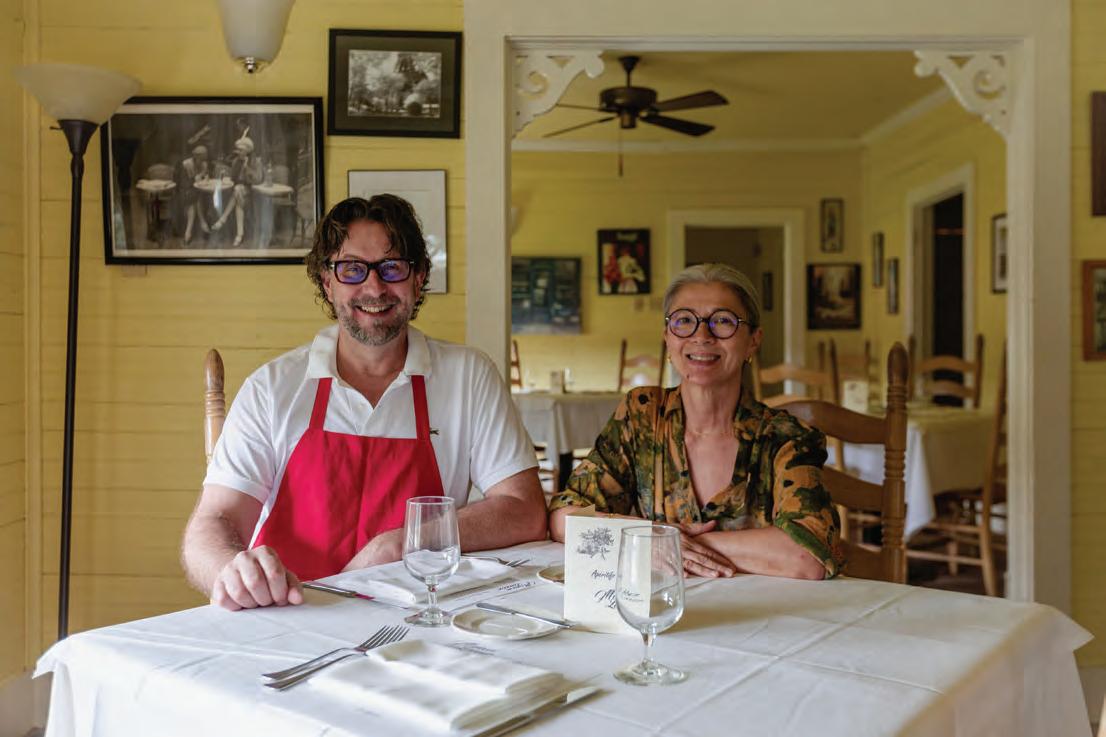
Eva and her sister, in Fort Walton Beach, Florida, and opened two restaurants, one French and one Chinese. Eventually, though, John wished to return to his roots in Baton Rouge.
After we finished the soup, Eva rewarded us with our appetizer, the archetypal French delicacy known as escargot, and another loaf of warm, crusty bread. Baked in a garlic butter sauce, the snails were served in six individual cups (as opposed to the more traditional tongs; this way, they were much easier to eat). My husband relayed his favorite snail joke while Eva opened a bottle of Henri Bourgeois Sancerre Rosé. While considering how the traditional French dish later influenced a New Orleans chef (Jules Alciatore at Antoine’s) to create Oysters Rockefeller at the end of the 19th century—I
were born. The young chef who took Prudhomme’s place at Commander’s was none other than Emeril Lagasse, who then opened Emeril’s in 1990. The few women chefs on the scene included Susan Spicer, who opened Bayona that same year, and “The Queen of Creole Cuisine '' Leah Chase—who was already a long timer at Dookey Chase Restaurant.
“USE GOOD INGREDIENTS. RESPECT THEM. LET THEM SPEAK FOR THEMSELVES.”
asked Eva if Louisiana’s culinary penchants for Creole and Cajun food had any influence on her mother’s French sensibilities.
She replied, “She didn’t pay any attention [to it].”
When Maison Lacour opened in the mid-1980s, Louisiana’s Cajun and Creole culinary scene was just starting to make a name for itself around the world. On LPB television, Justin Wilson was exclaiming “I gar-on-tee!” on his Louisiana Cookin’ show and John Folse was starting his enterprise at Lafitte’s Landing in Donaldsonville. Meanwhile in New Orleans, Paul Prudhomme left Commander’s Palace to open K-Paul’s Kitchen, where the quintessentially “Cajun” dishes of Blackened Redfish and Turducken
Gréaud, working from her cottage in Baton Rouge, was less well known than these culinary giants. But she was doing something distinct from the Cajun/Creole renaissance—she was introducing people to the highly refined ancestor of Louisiana’s increasingly popular indigenous cuisines. Classic French cuisine evolved from haute cuisine, an earlier style of cooking characterized by its meticulous preparation, elaborate presentation, and the use of high-quality and often difficult-to-obtain ingredients. Simpler but retaining the elegance of its predecessor, Classic French cuisine relies on fresh, locally sourced ingredients—much like its Cajun and Creole relatives. Yet, anyone who has ever tried to follow a recipe by Julia Child, the chef that introduced French cooking into American kitchens, knows Classic French cuisine requires much rigor, practice, and patience to turn out perfect soufflés and sauces like velouté and béchamel. Jacqueline mastered this art and remained true to the culinary traditions she was taught, following classic recipes that had been around for centuries.
As a frequenter of Maison Lacour, some of my favorite menu items include the Carré d’Agneau, a baked New Zealand rack of lamb, and the Saumon Grillé, broiled salmon with mustard sauce. A perennial favorite is the Flounder en Papillote—which literally means "enveloped in paper,” a cooking method popular in France since the 17th century. Served in a tangy, light cream sauce, the dish recalls Antoine’s Pompano en Papillote, created by Chef Alciatore in honor of the French brothers who developed the first paper hot air balloons. On
this particular visit, my husband selected the Côte de Veau, a well-sized veal chop, flambéed in cognac and served with sautéed mushrooms in a delectable cream sauce. I opted for the Canard du Chef. The slices of broiled marinated duck breast were deliciously tender, and the raspberry sauce added just the right touch of sweetness. The entrées are always elegantly presented, accompanied by an array of fresh green beans or asparagus spears, one small boiled potato, and a bright orange carrot slice, cut into a flower shape.
When it comes to the pièce de résistance, the desserts are fabulous. This time there were several chocolate selections: Mousse au Chocolate, Gâteau au Chocolate, white chocolate bread pudding, and Eva’s Chocolate Martini. For something lighter, we usually go for the Crème Catalane (Maison Lacour’s Crème Brulée). On this occasion, we closed our meal with a satisfying Café Noisette, a French style of espresso with hint of cream, spiked with Nocello, a walnut liqueur.
It has been more than twenty years since Chef Jacqueline retired, but her son-in-law Chef Michael Jetty says, “Jackie is with me every day on my shoulder.” Hailing from Michigan, Michael moved to Baton Rouge as an adolescent. He dabbled in the local restaurant industry and was a regular customer at Maison Lacour. Intrigued by the French food, he sought out Gréaud. He recalled, “I knocked on the back door [in 1991] and begged her [to take me on as an apprentice].” He trained under her for thirteen years, falling in love and marrying her daughter Eva along the way. He knew he’d finally made rank when one day, unexpectedly, Jacqueline told him, ‘Good job, Chef!”
He recalled that the first thing she taught him was to know your ingredients: “Use good ingredients. Respect them. Let them speak for themselves.” Michael acknowledged that in Louisiana we are fortunate to have many good local ingredients. He has access, for instance, to fresh crawfish, which are also served in France (écrivisse). Jacqueline also insisted on the importance of knowing your audience: “No one asks you if you like it. You are cooking for the people who are paying you.” She taught him how to be a steward of classic French cuisine, following recipes commonly recognized on the streets of Paris and in any French village: “Put away your ego. Who are you to change what has stood the test of time?” Michael declared Jacqueline to be the most interesting and smartest person he’d ever met. “We spent long days in the kitchen prepping, and she could talk about anything on any subject,” he said. “I learned a lot of life education from her.”
Jacqueline remains an important part of Maison Lacour’s story. As Michael put it, “It is most humbling to serve the grown children, and their children, of our founding customers and former staff members.” He said he and Eva never take their work for granted. “We stand behind what we do, fiercely.” •
Hours at Maison Lacour are 5:30 pm–7 pm Tuesday–Saturday. Reservations may be made by texting 225-333-7533 a week or more in advance. Cash or check only. maisonlacour.com.
IN LAFAYETTE, CHEF WILL BAXTER CULTIVATES A LITTLE CORNER OF PARIS
Story by Jordan LaHaye Fontenot • Photos by Paul Kieu

Upon walking into Jane’s, my husband Julien and I were greeted by the glowering visage of Vincent Van Gogh. The recreation of of “Self Portrait with a Straw Hat” sets the European tone of Chef Will Baxter’s restaurant, a space suffused with the French eclectic style of his late grandmother, the antiquarian Jane Fleniken. The décor is all hers, remnants of her legendary assemblage of fine French furnishings: gold-framed Marie Therese de Jaham paintings of dogs and ducks, a glittering chandelier with two glass roses extending outwards. A massive armoire filled with crystal occupies an entire wall. Some of the lanterns hanging in the courtyard still have price tags on them, in Fleniken’s handwriting.
Around twenty years ago, Fleniken, a recognized authority of French Provincial furniture for more than sixty years, worked with a contractor to create this building in the image of France’s Maisons à Colombage—a Tudor Revival style construction technique known in English as “half timbering,” which was popular in France in the late nineteenth century. A distinctive style consisting of exposed wooden beams with masonry filling the spaces in-between, Jane’s yellow bricks look conspicuously continental alongside the other homes lining Lafayette’s residential University Avenue. “I know it looks much older,” said Baxter of the building where his grandmother
lived and operated her antiques store for nearly twenty years. “But she worked hand-in-hand with the architect to design and make it look this way. She was a big fan of all things French.”
The antique shop’s transformation into a contemporary Parisian restaurant was part of Fleniken’s vision, too. In the final years of her life, she’d tell her grandson, who had just moved home after a Michelin-starred career on the West Coast, "I’d love to see you turn this into a restaurant after I’m gone.”
Our waiter asked for our seating preference. Afternoon rainstorms excluded the courtyard from consideration, despite the charm of lush greenery and red stucco. There is even a gazebo, partially enclosed by stained glass panels, with a table set for two. I was about to request we be seated in the room to the right, luxurious with deep blue walls, wood furnishings, and that remarkable chandelier. If you eat in that room, I’d heard, your wine is served in Jane’s crystal glasses.
But Julien was quicker, drawn to the activity in the main dining room— where we were delivered a front row seat to the drama of Jane’s open kitchen. There was Chef Baxter, absorbed in vegetable prep. For this, in the end, I was grateful (all the restaurant’s glassware is top-quality, anyway). After taking our wine orders (a 2020 Bouchard Père & Fils, Pouilly-Fuissé for him, a 2020 Réserve de Bonpas Côtes du Rhône for me), our waiter explained that the dinner experience here was to consist of three courses, all ordered together to ensure optimal timing. And then he, with great fondness, told us the story of Jane’s. Earlier that day, I’d had the pleasure of meeting with Chef Baxter himself, whose expanded version of that story centered around a grand sojourn through France with his grandmother in 2015. During those days, Fleniken would travel to France twice a year and load up shipping containers with antiques. “She took me to some of the best restaurants in Paris,” he said. “And man, you know, it just leaves an impression on you. Going there—eating that kind of food?”
Baxter at that point had already completed his training at the French Culinary Institute in New York City. He’d cooked at fine restaurants such as the Upper East Side’s French brasserie, Orsay, serving three hundred people a night. “Coming out of school and working in Manhattan, it was like out of the pan and into the fryer,” he said. “The standards were very high. Everything had to be perfect. Everything had to be consistent. That experience was really eye opening. It taught me what can be accomplished when you apply yourself.”
He spent time in Miami, cooking upscale Latin American cuisine under James Beard Award-winning Chef Michelle Bernstein, who he described as “an amazing influence”. And then, longing to get closer to home, he moved on to the New Orleans scene, where he
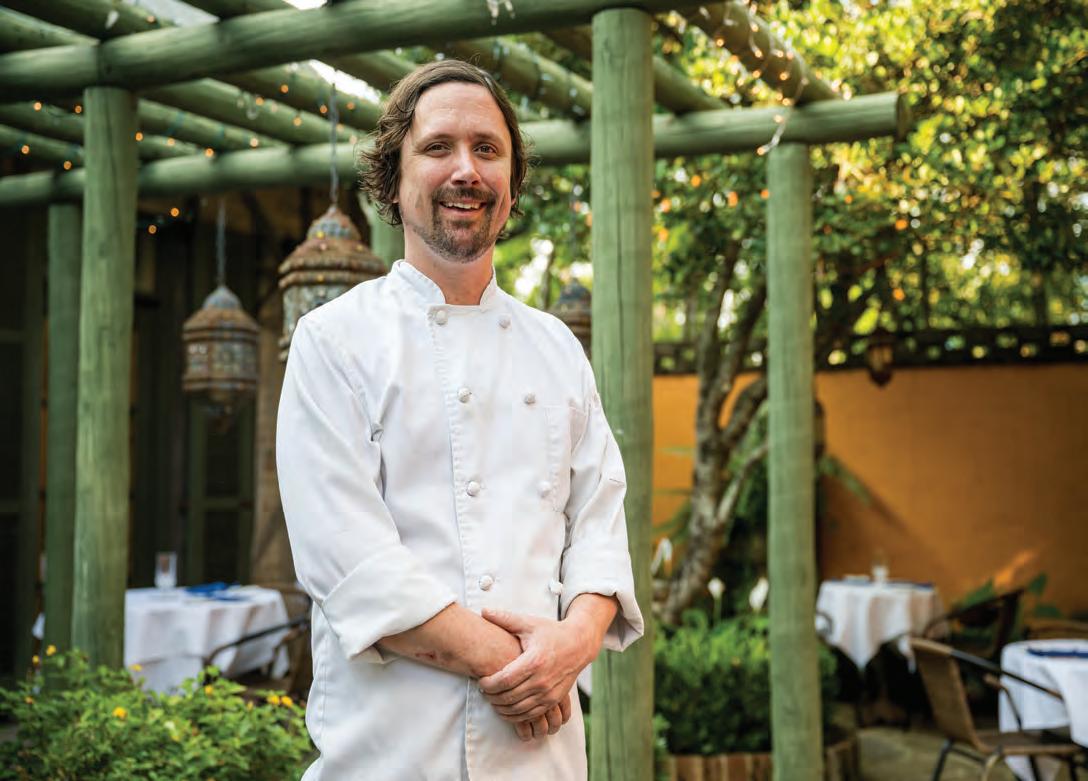

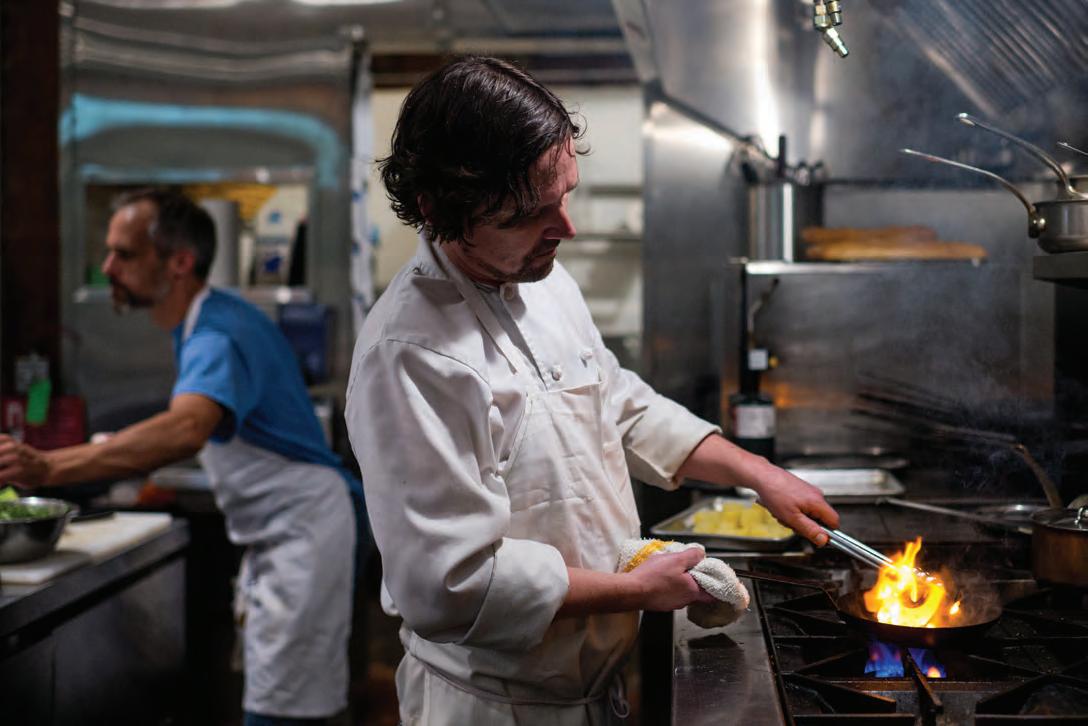
worked under Susan Spicer and at Scott Boswell’s ambitiously experimental Stella!—where he frequently cooked for the movie crowd, serving celebrities the likes of Harrison Ford, Robert DeNiro, Ryan Reynolds, and Blake Lively.
Baxter embarked on his French food tour with his grandmother around the same time he was getting started in the Michelin scene of San Francisco—an experience that showed him “how far you can take it”.
“You have to be obsessive, and unyielding,” he said. “It’s certainly not a way you can live your life. It takes a toll on your body, your mental state. But in San Francisco, that really instilled my passion for cuisine.”
All the while, Baxter was taking notes, storing information away for a
future restaurant of his own. “At that point, you know, I had been cooking for a while, but I hadn’t really zeroed in on French food,” he said, describing his interests in Spanish and elevated Asian cuisines. Being in France with his grandmother, though, lit a spark. And anyway, here in Lafayette, “French is in people’s blood,” he said. “But I didn’t want to go up against the people who have been doing the Louisiana French cuisine for decades. I wanted to do something different.” He wanted to serve food like he’d eaten with his grandmother, “as French as you can get”.
After almost five years in San Francisco, Baxter moved back to Lafayette to be near his family again. When Jane Fleniken died in 2018, aged ninety-three,
luxurious quality, quietly setting the precedent for the meal to come.
Baxter’s menu is ever-changing—“I am one of the only restaurants in this area that changes my menu entirely each season,” he claimed. The menu is a tableau of the best possible ingredients he can get his hands on, and the possibilities—all drawn from the French culinary archive—they inspire. “Premium ingredients, you know, even though we can ship them from other countries and grow them in greenhouses, ingredients are really the best when nature tells them to grow,” he said. “So, I do go entirely by the seasons. And then, I change things whenever we start to feel like a food factory. We’re craftsmen, artists. When we get bored with stuff, we change it.”
The menu itself is small and tightly curated. On the night we visited, Course One options included Caspian Sea Osetra Caviar, Spring Vegetable Chowder with Gulf Shrimp, an Endive and Watercress Salad, Seared Foie Gras, and Steamed Mussels. We opted for the chowder and mussels, which came to the table one following the other. The mussels, steamed in garlic, white wine, saffron, and mustard, were presented in a generous, dark bloom—their buttery centers little bright delights of flavor. We soaked up as much of the liquor in the bowl as the beautiful bread would accommodate, and I had to stop Julien from scooping the rest out with a spoon. The chowder, a well-balanced sorcery of light textures and rich flavor, went down just as easily and we returned both plates practically clean.
The second courses offered that night included a classic A5 Wagyu steak from the Miyazaki Prefecture of Japan (some of the highest quality beef in the world), seared in tallow and topped with smoked marrow butter. A life-changing dish, if you can swing it, with the $100+ price tag. As Baxter puts it, “I am slightly more expensive than most other restaurants in town, but it’s not because I’m getting rich. It’s because of how much these premium ingredients cost.”
Baxter’s mother and aunt inherited her French-style home on the corner of University and Taft, and the exquisite French antiques with which it was filled.
“We had to do two estate sales to get all the furniture out,” said Baxter. “There was so much in here.” Together, they began the process of transforming the space into Jane’s French Cuisine.
Baxter describes his initial vision for Jane’s as something similar to Chef Thomas Keller’s (of The French Laundry fame) Bouchon in Yountville, California: a French bistro experience marked by exceptional ingredients and next-level intentionality.
Today, that experience begins, appropriately, with a baguette, straight from the oven, and a hunk of imported French butter—simple pleasures of
Julien ordered lamb—a spring specialty at Jane’s and a favorite with regulars. Before it left the kitchen, we watched Baxter oversee his line cook’s meticulous preparation of the dish, quizzing him with the intensity of a master over his apprentice, “Did you season it? Did you taste it?” The boneless Colorado lamb loin came bathed in a Mediterranean Bagna Cauda sauce and accompanied by baby turnips, baby carrots, fava beans, and French breakfast radishes.
After agonizing between a Bacon Wrapped Boneless Rabbit Loin and Wild Caught Salmon, I took to heart our waiter’s point that the salmon— sourced from Oregon’s Columbia River—would only be available for a few short weeks. “This is really special stuff,” he promised. “I saw them bring the fish in earlier. It’s beautiful.” As the dish was
prepared, a sweet, exotic aroma stole into the room. Listening in, we learned from the kitchen that this came from the fig leaf parcel in which the filet was encased. When the fish arrived it was drizzled in spicy garlic honey and served beside Black Beluga Lentils and Charred Broccolini (which, I admit, knocked me out of the water for a relatively unassuming vegetable). The fish was perfectly flaky, the fig leaf drawing out its sweetness and buttery undertones. Plates were again returned cleaned, but with the portions so thoughtfully prepared—we gladly anticipated the third course, dessert.
With just two options that day, we simply ordered everything on the menu. The Belgian Dark Chocolate Crème Brulée came with biscotti and fresh berries, the decadent sugar cap breaking oh-so-satisfyingly to reveal thick chocolate custard beneath. Julien ordered the Mille Feuille, a crispy French puff pastry layered over a cream made of Madagascar vanilla bean and Mascarpone cheese, dusted in powdered sugar and adorned with fresh sliced strawberries. We went back and forth between the airy pastry and the indulgent
chocolate crème, finally sitting back in our chairs and declaring ourselves finis
On our way out, I was sure to make eye contact with Baxter, who beamed as we thanked him for the meal. Throughout the evening he’d been wholly absorbed, though not frantic, issuing orders like “Throw it in there—no butter! No butter at all!” and “Get a photo of that rabbit, that’s beautiful.” But now he grinned, and I remembered how he had described his craft earlier that day—"as a way to take science and art and fuse them into an amazing experience for people.” As we stepped through the front door, I noticed a photograph right beside it: Jane, fabulous in a blonde bob and pearls, holding a massive Persian cat. Bonsoir, Jane. Et merci. •
Hours at Jane's French Cuisine are 5:30 pm–9:30 pm Tuesday–Saturday. Reservations may be made at (337) 534-0442 or janesfrenchcuisine.com.

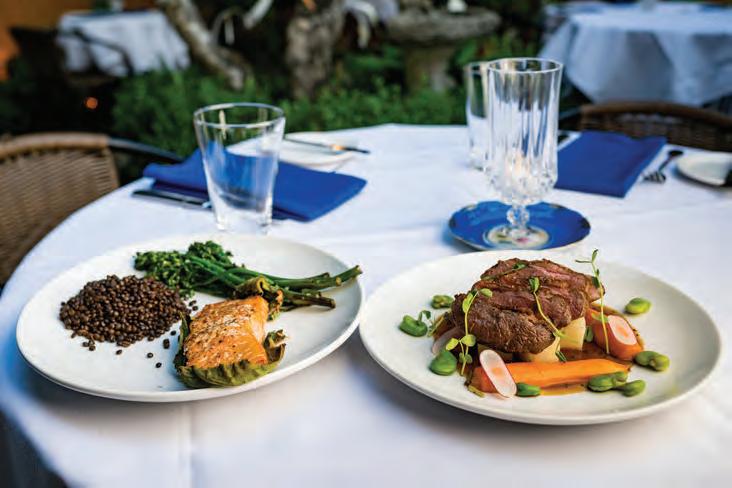







CHEF ROY GUILBEAU'S JOURNEY FROM HOTS
Growing up in Golden Meadow in the southern part of Lafourche Parish, Roy Guilbeau’s passion for the culinary arts was piqued at an early age. “My mom, God rest her soul, could not and did not cook,” he laughed. Taking advantage of the abundant access to the Gulf and Bayou Lafourche’s fresh seafood, he quickly became the household cook, and so began a lifelong passion for Louisiana’s homegrown culinary culture.
In restaurants, Guilbeau started behind the bar, where he translated his cooking skills into experimentation with drink recipes, flavor profiles, and cocktail products. He was working at a nightclub in Larose called HOTS, preparing to attend culinary school, when the Brennan family approached him to be a part of their new project at the time, Bourbon House. They wanted to hire him as front house manager. That experience taught him not only how to run a restaurant, but how to develop dishes using inspiration from your surroundings. He references the well-known story of Dick Brennan tripping on a pecan on his way to Commander’s Palace, the origin story of the now famous pecan-crusted Gulf fish.
Les 'Tites Affaires
After years familiarizing himself with various cuisines at restaurants like La Casa Del Sol in Thibodaux, Copeland’s Brass Pearl in Alexandria, and Broken Wheel Brewery in Marksville, Guilbeau met his business
partner Tara Rodney around 2017. A college friend of Guilbeau’s wife Joy’s, Rodney grew up in a cooking family helping to batter shrimp, brown meat for rice and gravies, and make Christmas candy. A self-taught, passionate home cook, she’d always wanted to open her own business. When she and Guilbeau began exploring the prospect of working together, they soon realized they were aligned in their desire to grow at their own pace. “I liked the idea of owning a business and trying to do things on our own terms,” said Rodney.
After discovering the abundance of agriculture in Rodney’s home parish of Avoyelles, and the nuances of “prairie Cajun” cuisine, Guilbeau began to envision a future restaurant in Central Louisiana. He was enchanted by the opportunity to explore the foods of Rodney’s upbringing and blend them with his own bayou roots.
Guilbeau and Rodney were in the process of looking for a location to open a restaurant when the COVID-19 pandemic hit. Like many others in the culinary world, they pivoted to focus on products they could make and sell from home. Though they had no formal baking experience to speak of, the two partners turned to the art of traditional French baking, and began selling their pastries at the Marksville Main Street Market. As they practiced the lamination technique of folding and rolling butter into dough and experimented with different fillings for their sweet tarts, known in traditional French baking as pâte sucrées, they quickly
found themselves with extra inventory. “We just posted on Facebook one day, ‘Hey we’re home right now. We have extra pastries if you want to buy some,’' recalled Rodney. And they began to build their business in the driveway, calling it La Petite Affaire Boulangers.
There’s some kismet in a traditional French bakery finding itself in the middle of Louisiana—where French culture has been reinventing itself for centuries. Established in 1807, Avoyelles is one of the oldest parishes in the state, settled early on by immigrants from Belgium, France, and free people of color of African-French descent—establishing a deep French Creole heritage in the area. The name of the restaurant is an ode to Rodney’s grandmother and a nod to the Louisiana French still spoken in Avoyelles. In Louisiana French, the word “affaire” can mean a "thing" or an "object". Rodney’s grandmother “Maw Maw” Voncile, a home cook, would give a “‘tit affaire,” or a “little taste,” of what she was cooking anytime she visited her house. The phrase can also refer to a “matter at hand” or a "small business".
In downtown Marksville, Guilbeau and Rodney’s “‘tit affaire” has turned into an approachable and accessible place to explore Louisiana favorites with a French flair. After establishing an enthusiastic customer base for the driveway pastries, they moderately scaled their menu and began offering weekly breakfast and lunch pop-ups in their current location downtown. In 2023, they fully transitioned to the brick and mortar, open-




ing four days a week for breakfast and lunch service. After four years of operating as a French pastry business with breakfast and lunch offerings, Guilbeau and Rodney recently expanded their hours to finally offer dinner service on Friday nights—beginning the journey towards Guilbeau’s long-held original vision of opening a restaurant in Avoyelles, with a menu fusing traditional French cuisine with Louisiana classics. On Friday evenings, the lights dim and table service is added, but the restaurant maintains the same cozy ambience of breakfast and lunch hours.
At La Petite Affaire, Guilbeau describes community not just as a concept but as a driving force that shapes every decision, from the menu to future investments. "What we do is for everyone,” he said. “For the community. Not just for us." On a personal level, Guilbeau explained that he has long craved the small-town way of life that he knew as a boy in Golden Meadow and is honored to discover, and help shape it, in Marksville.
This vision is reflected in the very atmosphere of the restaurant itself, which is housed in the former Raymond’s Department Store, a Marksville institution of over sixty years. It’s a place filled with memory. There’s a sofa for lounging, books for perusing, and a collection of children’s toys, allowing for the casualness and warmth necessary in a true community gathering place.
"We're starting to see that happen here,” explained Guilbeau when talking about the restaurant’s regulars, “and that's when my heart swells to know that this is something that we're providing for the community, that we're working so hard to create a place where they can feel comfortable.”
This philosophy extends beyond the restaurant's walls and into the kitchen, as Guilbeau and Rodney actively seek to support and invest in local people and their products whenever possible. Lion’s mane mushrooms, lettuce, pecans, and sweet potatoes— all grown in Avoyelles—are regularly featured in pastries and dishes.
Guilbeau believes there are certain elements in the terroir of Avoyelles that produce distinct and rich flavors. “In my opinion, a Beauregard sweet potato grown here is one of the most perfect foods,” he said. “Period.”
On a recent Friday night, the dinner menu at La Petite Affaire featured crab cakes, a nod to Guilbeau’s bayou roots, atop corn cream made with Avoyelles sweet corn. Fresh, local tomatoes were the centerpiece of the tomato basil soup, and oyster mushrooms added a subtle texture to creamy risotto. For the sweet finish, they took their chocolate and blueberry croissants and made a bread pudding that could stand up against any of New Orleans’s finest and most famous.
As Guilbeau explained, one of his favorite ways to flex his culinary creativity is by taking sweet pastries and turning them savory. “Taking Cajun and throwing it inside a French pastry,” he laughed, “That’s my life!” Some of his favorite crossovers include a pan au boudin, a crawfish étouffé tourtière (hand pie), and a fish en papillote featuring Atchafalaya catfish.




The French influence can be found not only in the dishes that come out of the kitchen, but also in the mentality that shapes the way Guilbeau and Rodney run their business. Guilbeau frequently references “mise en place,” the French culinary term for gathering or putting things in place, as an overarching philosophy for the restaurant. “When the guest is in their place enjoying their meal, when we are at our best into what we’re doing, that’s when the magic happens.”
It wasn’t the easiest birthday.
On September 23, 2017, the day Jeanne Green turned 35, she was in the hospital recovering from a double mastectomy.
Just weeks earlier, the married mother of twin toddlers had been relaxing on the sofa when she felt a suspicious mass under one breast. A mammogram and biopsy were performed, leading to an unexpected diagnosis: hormone positive breast cancer. Consulting with her doctors at Mary Bird Perkins Cancer Center and Woman’s Hospital, the Louisiana native decided to proceed with a double mastectomy.
“The doctors said I should definitely remove one breast given my young age,” Jeanne says. “And this was a way to reduce the chance it would occur in the other breast.”
That decision wasn’t Jeanne’s only strategy in protecting her body from a cancer recurrence. A longtime culinary arts professional with years of experience in cooking and food sales, Jeanne immediately turned to nutrition to help her body heal.
She began making collagen-rich bone broth to build protein and strength during the chemotherapy and radiation that followed her mastectomy. And after experiencing the digestive troubles that can accompany chemo, Jeanne started to make and consume fermented veggies and sourdough bread that are rich in probiotics. She also switched to a mostly organic and vegetarian diet, since a low-fat diet is often recommended for hormone positive breast cancers.
Jeanne understood enough about the fundamentals of food to craft her own strategy, but she also ran it by Mary Bird Perkins Cancer Center’s team of dietitians. The Cancer Center offers dietitian services on all its campuses as patients navigate their individual cancer journeys.

“How you eat plays a big role in your recovery,” said Mary Bird Perkins Cancer Center dietitian Vadel Shivers, PhD, RDN, CSO, LDN, a 21-year team member. “We make sure that patients are given evidence-based resources about nutrition during their treatment.”
One of the most important things to remember, Vadel says, is that each patient has different needs. A Cancer Center dietitian helps them develop a plan for eating healthily throughout the process. This could include strategies for fighting nausea during chemo, maintaining a healthy weight if medications cause weight gain, and eating small meals to fend off loss of appetite and rapid weight loss.
“It could be something as simple as making sure a patient is eating three main meals a day and one snack,” Vadel says. “Or it could be suggesting someone eat every two or three hours.”
Diet can also be used to help address fatigue, another common occurrence during treatment. Vadel says she keeps a close eye on her patients’ fluid intake to be sure they’re staying well-hydrated, one of the most important factors for fighting fatigue and encouraging healing.
As for Jeanne, fermented foods and a healthy, active lifestyle are still her main weapons for remaining cancer free. Along with raising her now eight-year-old children at their home in St. Francisville, she also runs a meal prep business helping others live a healthy lifestyle.
And when she encounters friends or neighbors facing a cancer diagnosis, she might offer to make them some bone broth.
“I’m happy to share what worked for me,” she said.



“It took us three years of our life to learn how to make this,” said Rob Forster as he poured me a taste from the freezer of Wonderbird gin, No. 61.
Forster is one of Wonderbird Spirits’ three owners. I took the scenic drive to the distillery in Taylor, Mississippi on a Monday afternoon, less than twelve minutes from the Historic Square in downtown Oxford—home of William Faulkner, the University of Mississippi, James Beard Foundation Award-winning restaurants, and a community known for enjoying a strong gin and tonic on a sweltering August day.
In 2019, Chand Harlow and Tom Alexander, along with Forster, uprooted their lives to create the first grainto-glass gin in the state of Mississippi. They are also the only distillery in the country and one of three in the world creating gin from rice as their substrate.
Recently having completed a new expansion, tripling the distillery’s physical and operational footprint, the team at Wonderbird is now on the path to take their influence to the next level. I wanted to know how far beyond Oxford the partners intend to take the spirit. What sets Wonderbird apart in the lineup on the liquor shelves, so much so that these three guys left their careers to spread its gospel? And five years in, what’s the next step?
“We went through this huge, long deal of fun when we learned how to make this,” said Forster of the sample he’d prepped for me. “She's been our flagship for three years now.” He described Wonderbird’s signature gin as starting out similar to sake, pointing to the traditional Koji cabinet sourced from a Nashville sake maker. Made from Suki wood, a Japanese cedar, the cabinet meticulously controls the temperature and humidity to allow for ideal fermentation conditions. “We take a bunch of our rice, clean it, and steam it in that mash cooker, and then inoculate it with a mold spore that we import from Japan called ‘Koji’ to ferment,” explained Forster. The Koji then breaks down the rice on a molecular level, releasing the sugars. They are essentially making sake as the first step of the gin, not dissimilar to the beer-like stage of whiskey and bourbon.
Every bottle at Wonderbird is hand filled, labeled, and shipped out from their small facility. The sample I tried was in a tasting vessel thrown by potter Keith Stewart a few miles down the road in Taylor. In front of Forster was a box with a thimble-size measures of the ten botanicals used in the spirit, and the local rice that is its base.
The label of “61” on the flagship gin, which is created using rice from Two Brooks Farm in Sumner County, is a tribute to the fact that this batch was the sixty-first attempt at creating the perfect botanical combination during the recipe development stage. In true grain-toglass fashion, each botanical is carefully sourced, some from the very field the distillery stands on.
“Two of the ten botanicals are foraged from our land: red clover—which grows all over our pasture, all over the Mississippi highways, and imparts a bit of a chamomile-ish note and earthiness— and then, southern pine needles from trees in our back pasture.”
To ensure a consistent product, Alexander carefully manages the botanical sourcing and setup in the distillation process. “We went through probably seven or eight

types of juniper berries before settling on the ones we use for our gin,” he explained.
The novelty doesn’t stop with the sourcing of the botanicals, but extends to how they are imparted into the spirit. Wonderbird is known as one of the only distilleries in the world to distill each of their botanicals individually, rather than en masse, through dry vapor distillation. “We manifest that as perfectly as possible and combine them after the fact.”
This separate vaporization process is especially important for their experimental gins, such as the limited-run Magnolia expression, No. 97, which has five botanicals, including highly fragrant, dificult-to-source magnolia petals.
“We go around town with cases of the flagship No. 61, and we go to people's doors and say, ‘Hey, I’ll trade you a bottle of gin if I can go in your back yard with this pulse saw and take some of your magnolia flowers,’” said Forster.
After the Magnolia experimental, which itself was stunning, Forster poured me a glass of the gin he was most enthusiastic to share: one of several experimental cask-finished gins, all limited to one-barrel production in a single fifty-three gallon drum. The process produces 263 bottles, “and then it will never exist again in the world,” said Forster. I am not usually a person who seeks out floral notes, so I was unsure if this would be to my taste. I was pleasantly surprised. It was soft, buttery, light, and had a hint of summer. It would be excellent on its own with a subtle tonic or possibly with cucumber.
The final gin he shared with me was a Weller-cask finish of the flagship, No. 61. As someone whose first drink of alcohol was straight out of a fifth of Old Weller Antique at the Southern Foodways Alliance Symposium (other than a communion-sized sip at my grandmother’s during Christmas), I was elated to try this cask-finished gin. The flavor contained the oak-ey, caramel, vanilla, and somewhat chocolatey notes of a Weller without tasting so dark as to remove the light and smooth texture of the carefully curated botanicals.
Wonderbird’s recent operations expansion will bring opportunities to delve deeper into the local markets where they are currently, in addition to targeting some heavy hitters like New York, Chicago, and D.C. Wonderbird is currently in liquor stores and on bar shelves in Mississippi, Alabama, Louisiana, Tennessee, Georgia, South Carolina, Texas, and the Florida Panhandle, with some placements in New York and California.
Cultivating its place in the Mississippi culture for locals and visitors, Wonderbird hosts appointment-only cocktail experiences at the distillery on Thursday nights. Intimate, with a simple, limited menu and a tour of the facility, the evening gives customers a chance to connect with the spirit as well as the people who make it—creating a lasting impression. “Those folks go back to Memphis or go back to wherever and say to the folks back home, ‘Man, you guys got to check that place out!’”
In May, the team’s outreach fostered an opportunity to host Neal Bodenheimer, the James Beard Award-winning owner of CURE in New Orleans, for a signing of his book Cure: New Orleans Drinks and How to Mix Them, and a
conversation with City Grocery owner/chef, John Currence. Over two hundred people attended.
“Neal taking the time to come to Oxford and associate his name with our brand is such a gift,” said Forster. “Hearing John and Neal, two James Beard Award-winning chefs, talk about their time behind the bar and their upbringing in New Orleans, and truly share their passion for what they do made the evening magical.”
He and his partners are hopeful to host more high-profile spirit and culinary events in the future. “Executing an event of that caliber in our newly updated distillery space puts a lot of wind in our sails for the road ahead.•
Wonderbird Spirits can be shipped to thirty-six states across the country, at wonderbirdspirits.com. Or, plan to visit in person on Thursday nights for cocktail service; reservations required.








By Sophie Nau








It was a winning night for New Orleans at this year’s James Beard Awards. Dakar NOLA, the Senegalese restaurant in Uptown New Orleans that started off as a pop up by Chef Serigne Mbaye, took home Best New Restaurant. Mbaye's team joined him on stage to accept the award all together. “I always knew West Africa had something to say,” Mbaye told the crowd. “Think about Southern food without West African influence—what do you really have?” He thanked the people of New Orleans, “who truly embraced me like one of their own,” as well as the staff smiling behind him, who continue to accomplish his vision of thoughtful Senegalese food, night after night. dakarnola.com.
Best Bar Program went to Jewel of the South, known for its expert handling of boundary-pushing spirits (like in the Pouves-Pous Poulet, made with a chicken-fat washed rum) and proudly-executed classics in a nineteenth century Creole cottage on an outer corner of the French Quarter. When accepting the award, partner and veteran bartender Chris Hannah shouted out the team slinging drinks back home: "To everybody working at Jewel of the South, we have two bottles of cognac at Black Penny (and a gang of non-alcoholic beer) ready for you when you get off work.” jewelnola.com. jamesbeard.org.
Manchac classic Middendorf’s turns ninety on July 4, celebrating the long journey since Louis and Josie Middendorf opened the restaurant in 1934 with a $500 loan. At the time, former traveling salesman Louis served drinks, establishing a chatty repertoire with locals and visitors, while Josie helmed the kitchen, where she dreamed up their signature thin fried catfish. Eventually, their son Richard took over the restaurant, and the Middendorf family ran it until current owners Horst and Karen Pfeifer bought the institution in 2007. Today Middendorf’s operates a second location in Slidell, and both spots are as lively as ever, cooking up classic seafood dinners, broiled shrimp with lemon butter, or catfish and oyster combo platters. To celebrate the big birthday, the Manchac and Slidell locations will be dishing out slices of cake and hosting live music all weekend. middendorfsrestaurant.com.
When the pandemic forced restaurants to shutter dine-in service, husband-andwife team Isaac and Amanda Toups of Toups Meatery in Mid-City New Orleans started packaging “family meals” (the staff meal many restaurants partake in before service) for their employees to take home. Before they knew it, the operation grew to the point where they were feeding 500 people a day. In eighteen months, the Toups had distributed almost 100,000 boxed meals to community members looking for a good meal and a little comfort, before wrapping up the program. However, this year, the Toups cranked up the stoves once again to serve students without access to regular meals in the summer months. In early June, Toups Family Meal delivered 3,186 meals to 531 food insecure households, and hopes to do the same in July. While largely self-funded, Family Meal is also seeking donations to help it meet the costs of delivering weekly meals to over 500 students. toupsfamilymeal.com.
Culinary enthusiasts take note. The Natchez Food and Wine Festival returns July 26–27 with a record number of chefs cooking up specials throughout the weekend, along with hosts Molly Manning and Christian Velez, both contestants from Food Network’s Spring Baking Championship
“I’m really excited about the future and growth of the festival,” Manning said. “We took a long break after COVID and now we’re back and better than ever.” Don’t miss the always popular Friday Night Tastings Along the River, a chance to sample offerings from regional and local chefs, vintners, and craft brewers at the Natchez Convention Center. VIP ticket holders are invited to the after party at Smoot’s, where they can meet the chefs and sample cocktails from a full bar provided by Cathead Distillery. Cookbook signings, wine dinners in Natchez’s historic locales, and a “Food is Art” dinner at Conde Contemporary Art Gallery are all a part of the weekend’s festivities. natchezfoodandwine.com


THE RENAISSANCE MAN THAT WAS TONY CHACHERE, AND THE CULINARY EMPIRE HE BUILT
Story by Kristy Christiansen • Photos by Paul Christiansen
Louisiana is famous for its food and its cocktails, for its coffees and spices. But where do all these products begin? We (writer-photographer duo Kristy and Paul Christiansen) are on a mission to discover the origins of some of our most famous and unique locally made products through the bi-monthly Country Roads series, “Made in Louisiana”.
There’s no mistaking the Tony Chachere’s factory— its giant, Instagram-worthy branded seasoning silo beckoning from the Interstate. We trekked to Opelousas to take a peek inside the home base of one of Louisiana’s most beloved seasoning blends and learn a little more about its namesake and founder, Tony Chachere.
Tanya Bellard, Customer Service Manager, met us at Mr. Tony’s Country Store, a gift shop for all things Tony Chachere’s and visitor entrance to production viewings and a historical film. She brought us straight back to the viewing room, where a wall of windows separated us from the massive warehouse beyond. Workers walked the production lines, examining products as the conveyor belts hustled shakers and boxes across the room. While we observed the nonstop activity, Bellard explained how Tony Chachere’s grew from one man’s homemade spice mix into the massive enterprise it is today.
Born in 1905, Chachere grew up in Opelousas, and he and his wife, Patricia, raised their family in the home that now houses the Lafon-Ardoin Funeral Home. Growing up in the thick of Cajun and Creole ancestries and culture, he loved to hunt, fish, and especially cook. He would often bring visitors and friends to his camp in the Atchafalaya Swamp to impress them with his home-
grown culinary skills. Although not a trained chef, many around Acadiana referred to Chachere as “Ole Master.”
A pharmacist by trade, he also worked as an insurance and pharmaceutical salesman. “He was into everything, tried anything he could, and if it succeeded, that was his path,” said Bellard, who listed off several of Chachere’s ventures—including a pepper sauce, a makeup line, a bug spray, and a book about how to train your dog. It was when he retired from the insurance business in 1970, though, that “he fell into the seasoning,” according to Bellard.
Chachere published the Cajun Country Cookbook in 1972, which included recipes he’d collected over the years. The staple ingredient in every dish was his personal seasoning blend, for which he also provided the recipe. Chachere sold the first ten thousand copies in a matter of weeks from the back of his station wagon. As the cookbook circulated, people started approaching him to ask where they could buy the seasoning, rather than having to make it themselves. So, he started whipping up large batches of the stuff for sale—packaging it in mason jars.
To say Chachere’s seasoning took off is an understatement. He began making guest appearances on radio and television shows across the South and cooked for several Louisiana governors and Miss
America. In March 1995, Chachere became the first inductee into the Louisiana Chefs Hall of Fame. A week later, he died, three months before his ninetieth birthday.
Today, operating in Opelousas out of a 150,000-square-foot facility and employing over 130 people, Tony Chachere’s is still a family-owned business. Tony and Patricia had six children, five of whom lived into adulthood, and representatives from each of the families reside on the company’s board. To mark the company’s fiftieth anniversary, the Louisiana Legislature declared June 14, 2022, as Mr. Tony Chachere Day.
Over the years, the product line has expanded to now include six seasoning blends, including bold and no salt varieties, salad dressings, injectable and pourable marinades, multiple dinner mixes, roux and gravy mixes, crab boil and fish seasoning, and even a bloody Mary mix. In the next year, the company will also debut a line of chili mixes, stuffing mixes, and a variety of new seasoning blends. All the dry goods are made from scratch to finish in the Opelousas factory. It all starts with mixing the seasoning blend, which is then either packaged or added to other products before being boxed up and loaded on trucks to ship out. “Our original Creole seasoning blend is our core flavor identity,” said Celeste Chachere, the Director of Marketing, Sales, and
PR for Tony Chacheres, and Tony’s great granddaughter. “It is the building block of all our products. Our customers know and love us for that unmistakable flavor.”
“Our biggest seller is still the original seasoning,” echoed Bellard. “That is our bread and butter. That’s what made Tony Chachere’s what it is today.” Bellard explained that when more people started cooking at home during 2020, demand surged. And it hasn’t gone down yet. “We had to hire more people and expanded production, and we never really lost what we gained in COVID.”
Two of the seasoning lines run twelve to twenty hours a day, sometimes seven days a week, with over 100,000 thousands of cans rolling off the lines daily.
All of the products are proudly displayed and sold in Mr. Tony’s Country Store, along with his Cajun Country Cookbook, Tony Chachere’s-themed merchandise, and an array of Louisiana novelty items, such as kitchenware, books, and holiday decor. •
Mr. Tony’s Country Store is located at 5604 I-49 N. Service Road in Opelousas, Louisiana. Regular store hours are Monday-Friday from 9 am–4 pm, with production viewings Monday–Thursday.
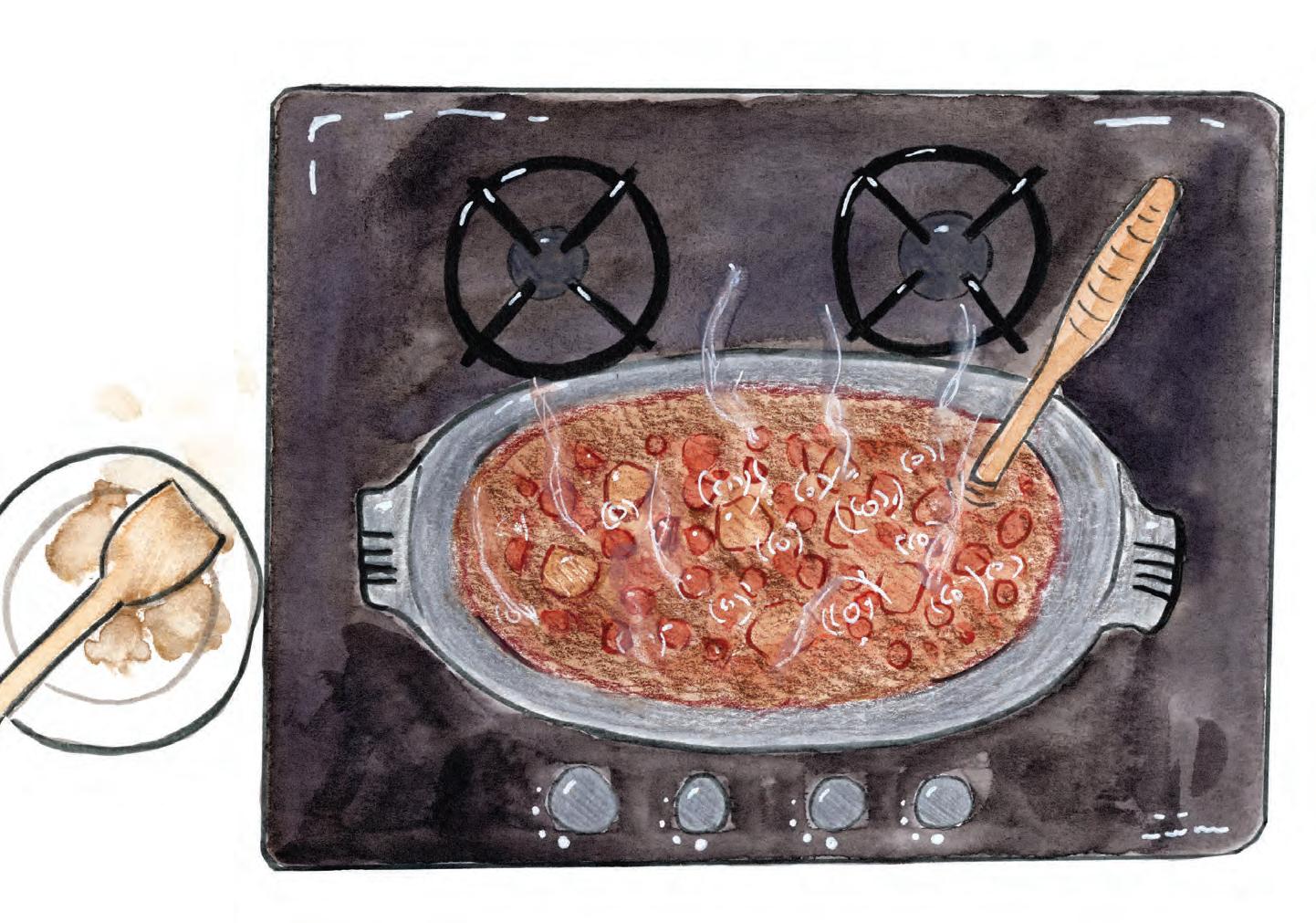
FANTASY VS. REALITY
Story by Megan Broussard • Illustration by Kourtney Zimmerman
Fantasy: My kitchen is a spacious culinary oasis. Every inch of it shines except for the stove, which sparkles. Hummingbirds tap “hello” to me on the French windows overlooking my private prairie, while wildflowers wave to the beat of Le Roux’s “New Orleans Lady”. All of my appliances are personal gifts from Chefs Paul Prudhomme and Emeril Lagasse. Also, my granite countertops are blessed by the pope.
Reality: My kitchen is a minefield of stray shoes, book bags, and dog toys. It overlooks sweeping views of dead grass, rusted barrels, and a Walgreens. The linoleum countertops shimmer in the natural light with residue of that time my five-year-old smashed two glitter bombs together to see what would happen. All of my appliances are cherished gifts I bought myself half-off at Target. Once, Marie Kondo was supposed to film an episode here, but canceled in the end, saying the space sparked joint pain.
Fantasy: I saunter out into my vegetable garden that mulches, fertilizes, and weeds itself. The onions, bell peppers, and celery are perfect despite the morning monsoon. I call out to my husband to fire up the forge and make a custom cast iron gumbo pot. Our children meet us in the kitchen to complain: “Mommmmmm, please won’t you let us help you more around the house?” Before I can refuse, they make a game out of grinding flour, then finish up the potato salad. I let out a loud blissful sigh, then grab a butcher knife. In the barn, I am relieved to find the chicken I’ve come to kill has died peacefully in her sleep. Same for the pig! They’ve even left a will. They do not want to be buried or cremated or creamed. They demand to be gumbo’d.
Reality: I limp to the fridge after stepping on a lego and rummage for string cheese. Then I remember why I came here. Oh yeah, dinner. I locate the onions and celery but can’t find the bell peppers I bought for that TikTok recipe I was supposed to try. Then, I scrape its remains off the shelf before driving to Rouses. I spend eight minutes talking myself into splurging on the pre-chopped container only to realize they’ve just run out. After picking an onion, then picking up the avalanche of onions, I’m stuck in traffic. I call my husband to pick up the kids from practice and draft a text to respond to what I know is coming next: the response: “Where’s practice again?” When I’m finally home, I realize my mistake and get right back in the car, this time heading to Albertsons. I can’t have the cashier at Rouses knowing I also forgot the chicken.
Fantasy: I fetch a zinfandel from the cellar. ‘Twill pair perfectly with la petite snack I whipped up to nibble on while I cook: two stuffed Dungeness crabs with homemade remoulade sauce and a jumbo shrimp. Next, I pour un verre de vin and hold it to the light, then swirl it ‘round and ‘round for eight minutes to admire its color. Slow at first, then slower. Then, super slow like a glitching stop-motion windup doll. Finally, I take a sip, swish, and spit it out … for I am buzzed!
Reality: I grab an old Mardi Gras cup and pour whatever flavor Truly is left from last week’s in-law visit. Then, I have two more, plus a bag of Flamin’ Hot Cheetos, a half sleeve of Tate’s and a handful of those sour gummy fish thingies near the register at Trader Joe’s. It all tastes disgusting together so I call my bestie to tell her. She doesn’t answer, so I leave a voicemail that says: "I love you I’m drunnnnnnnnk call me back, bitch”. A few minutes later she does, but now I don’t feel like talking, so I pretend my phone died.
Fantasy: After I combine the holy trinity, season the chicken, and give the andouille sausage a full Swedish massage, I roll out the gramophone. My secret to a true roux? Blasting saxophone solos out of a fourteen-inch horn. The rhythm takes me back to my days as a lounge singer à Paris. The dark smoky rooms, the adoring fans, the old flame who still visits me in my dreams . . .
Reality: “SOMEBODY CALL 911!” I yell, along with Sean Paul blaring from the entertainment center. “Shawty fire burnin’ on the dance floor.” I pop, lock, and drop it, then struggle to unpop, unlock and undrop it, feeling around for a drawer knob strong enough to pull me up. That’s when I have a flashback of my twenty-first birthday on Bourbon Street. The questions start flooding back: What was I thinking? Whose idea was that? And how the hell did we make it out of our twenties alive?!?
Fantasy : I could stir roux all day, so I do. The oil and flour pop vi olently onto my eternally youthful skin. It burns so good and mirac ulously never leaves a mark. In fact, it’s a regular part of my skincare routine. I put a little under my eyes, my T-zone, and my WB-zone (whole body). Gwyneth Paltrow’s buyers at GOOP are in touch.
Reality: My muscles are sore from trying to take off my sports bra yesterday so this stirring crap is pushing me over the edge. Great, took one second to stretch, and now the roux is burned! I toss it out and crack open a jar of Savoie’s.
Fantasy: Wow, eighteen hours of unnecessarily hard labor flies by! I taste it to be sure it’s perfect (I already know it is) and am immediate ly transported to a meeting with God. He says to me: “I can’t tell you that you already have a spot up here in heaven buuuuuuut….” He winks. Then He blesses the roux, me, and my future. I return to Earth to share bowls of gumbo with my family, who compliment me incessantly for the next hour and a half. We all sing “Kumbaya” until we fall asleep.
Reality: I’m not even hungry for this anymore. Plus, isn’t gumbo bet ter the second day? And after all this work, don’t I deserve a little treat? I tell the fam our new supper plans; we’re having Raising Cane’s in stead. They cheer! Then I hop in the car before they can ask to come with. During that twenty-five minute drive, I experience true peace.
E NRICHIN G COUR SE S TAILOR E D FO R ADULTS 5 0 AN D AB OVE
C OU R SE S AVAIL AB L E IN BATO N RO UG E, ST. FR A NCI SV I LL E SL ID EL L AN D NEW ORLEANS
FALL COURSES START SEPTEMBER 23
JO IN TODAY AT C E. LS U. ED U/ OLL I




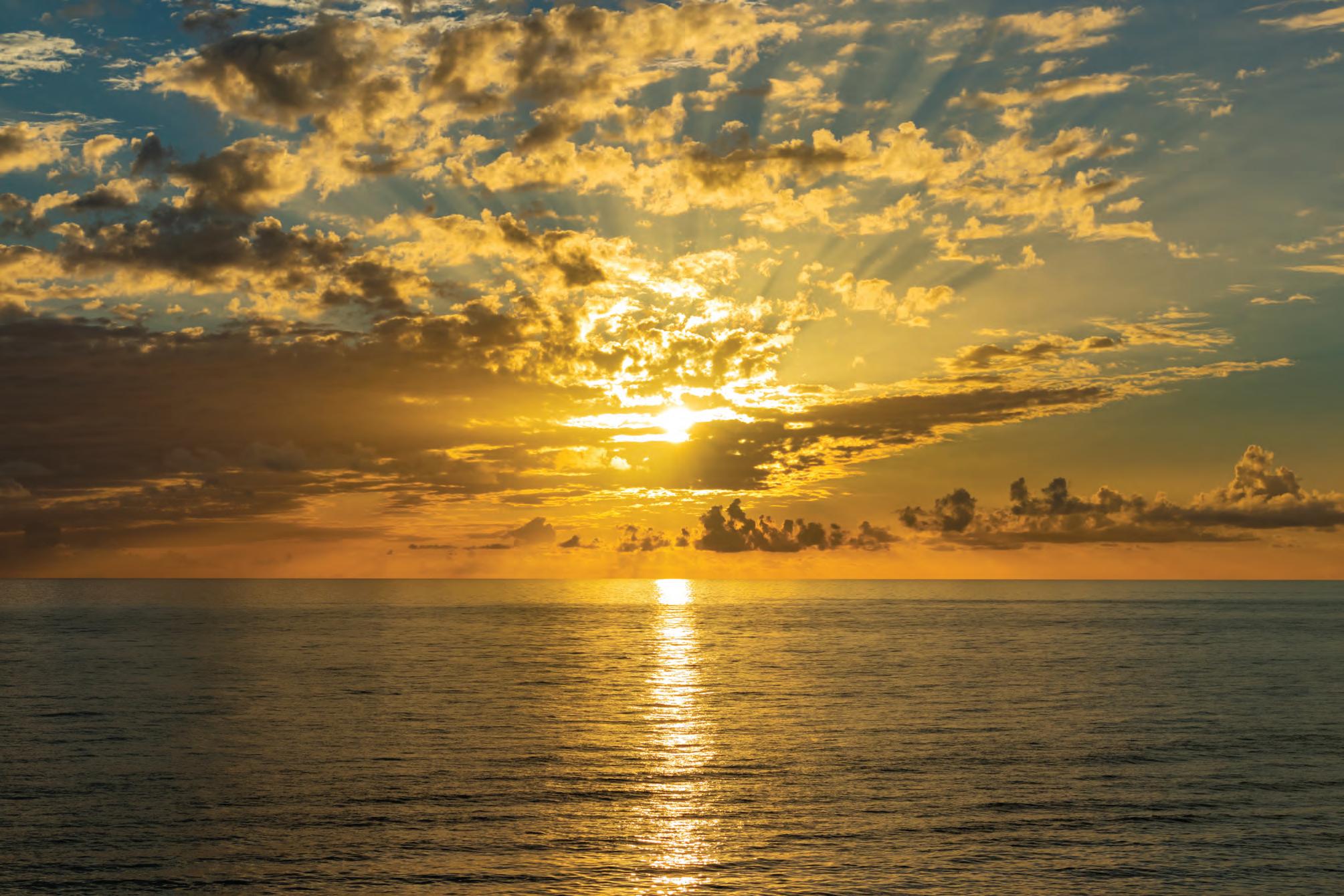

CUTTING BACK, INVITING ABUNDANCE
Story by Jess Cole • Photos by Nikki Krieg

Idays, we rarely lack for rain, and the earth rarely freezes. This creates an almost year-round growing season. When I am in shorts and eating at the harvest table bounties of squash, peppers and okra, my gardener friend from upstate New York is usually awaiting the end of the last frost and starting to plan out their summer garden. Their “summer” is our spring, summer, and fall all in a few short months. All that to say: we can grow for a long time. Here in the humid deep South, though, there are certain caveats. One that I find of constant
interest and study is the art of perennial pruning. Come early July, I have already spent a lot of time pruning, deadheading, and cutting back my perennials and annuals—native, exotic, all of the above. The action of pruning herbaceous plants finds its roots in ancient natural history. Plants have been “pruned” by various ways of disturbances, since their creation. Examples of these natural disturbances/ prunings include: grazing animals and natural patterns of weather such as fire, flooding, and wind. Humans, for their part, have pruned, for various reasons, since we began cultivating plants and gardens.
There are four reasons I like to prune my perennials (and annuals) often:
More blooms!: When most herbaceous plants go to seed, they start to end their perennial or annual life cycle. Plants, like most species of the earth, have the same evolutionary goal, and that is to carry life onward. Though there are exceptions, generally when a plant has put its seed out, it has completed its yearly responsibility for its species and can, for now, end its reproductive cycle.
Therefore, when you prune or deadhead your herbaceous flower heads before they go to seed, you are sending a message to the plant that its work is not done. You are, in essence, telling it to keep making blooms.
Structure: The main reason I prune perennials is for structure and strength. To encourage new robust growth and help plants avoid splitting or rotting, pruning certain perennials by half or two-thirds a couple times a year can do a world of good.
There are a few of my native perennials I purposely prune hard at least once late spring, many months before they bloom. These include: swamp sunflowers (Helianthus angustifolius), Willowleaf Aster (Symphyotrichum praealtum), ironweed (Vernonia gigantea), and all of our goldenrods. These plants are what I like to call “ditch plants” for the fact that they grow in low spots along our roadsides. These ditch plants, among many many others, grow wild and tall. In a giant mass, or at the back of a garden, they may stand up fine but most often than not, in the residential garden, they grow too tall and topple over. We like to cut them back early enough before blooming so they are stronger, a bit more compact, yet still bloom in the fall.
You can also prune to encourage a certain type of structure and shape. I, for example, often like to prune a bit of the plant's structure to encourage a cascading effect.
Illusion of Beauty/Health: When you deadhead or prune browning flowers, it just gives an overall beautifying effect to the garden. It is wild how different a garden can appear after a good removal of spent blooms. It does not mean the plant is any happier, it just gives an appearance of perfection and an illusion of more vibrant color. I used to deadhead a lot for this reason alone, especially with my seasonal annuals. Alas, I no longer have as much time for that, but when I can do it, it’s well worth the meditative task.
Plant Competition: All plants have different growth rates and natural forms. Some perennials will quickly overcrowd others due to a faster growth rate or more wild form. You can solve this problem by (1) choosing carefully what plants you plant alongside each other and (2) pruning when needed if one perennial or annual crowds over another.
There are some gardens you don’t want to prune at
all, of course. In some gardens, you might leave the brittling grass blades and bronzing seed heads through winter as resources for our wildlife to munch on and find refuge within.
As someone drawn simultaneously to more naturalistic styles of gardening and heavily blooming cottage gardens, I have some more naturalistic areas of my garden for my seasonal musings, and other areas that are more controlled. My overall approach is to aggressively prune/ deadhead through the summer and then stop come mid-September. As I watch winter slowly seep in and with it the various shades of browns and fluctuating textures, I let go of control.
Pruning itself is an interesting study in control and our obsessive human need to cultivate spaces. But I also find, at the end of the day, it's an art. No one is out there enforcing rules of how to interact with the plants of your garden, not even when it comes to how to chop away at it. You learn, through trial and observation, what works for your space and through what lens you most enjoy viewing it. There’s no real wrong way—it all depends on your goals/ objectives. As always, experiment away. •
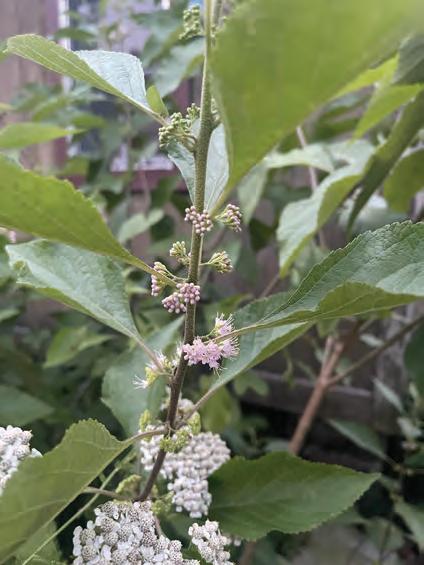

in South Louisiana. Aside from finally gaining the mainstream landscape popularity that she de serves… Beautyberry lines all of our woods, grows in our pastures, roadsides, and more. She seems to grow well in all soil conditions, yet never seems to be too weedy within the garden. She’s gorgeous in mass, as a hedgerow or a specimen, with a wild spindly growth pattern that can also be pruned to appear more compact and clean. Clusters of the sweetest tiny pink blooms are followed by gorgeous purple fruit. The plant was used by Native Americans to repel mosquitos. We find it to be effective! The American Beautyberry is a most fragrant and delicate addition to your garden.








A THIRTY YEAR COLLECTION TRANSCENDS KITSCH ON MAGAZINE STREET
By Rick Arnett
“One minute, we were picking out a trinket at a Cajun gas station, and the next thing we knew we owned one of the largest collections of alligator salt and pepper shakers in the world,” said Liz McDade. After thirty years of collecting all things alligator, Liz and her husband Robert now own the Great American Alligator Museum on Magazine Street.
Six months before Hurricane Katrina
in 2005, they purchased a building in the Lower Garden District on Magazine that needed some work, especially after the storm. Their vision included keeping the architectural character of the mid-19th c. New Orleans neighborhood while showcasing America’s deeply-held fascination with the alligator through the couple’s massive collection of paraphernalia to the public.
It took almost twenty years before the vision was finally brought to fruition, in part because of the struggle to
secure contractors in post-Katrina New Orleans. When COVID-19 brought the world to a halt, the couple began cataloging and curating their whimsical collection in earnest. Liz even sewed the alligator patterned curtains for the street-front windows. The Great American Alligator Museum opened April 1, 2022 to little fanfare, but public interest grew quickly.
“Locals started popping in,” said Liz. As word spread, groups and tourists made their way to see the only museum
in the world dedicated to Alligator Mississippiensis. “School tour groups, birthday parties, an art group from Tulane, and a Trinity Episcopal photography group have visited. It’s interesting, too, that kids respect it as a museum. Parents bring in little kids, two to three years old, teaching them about alligators. Kids love it.”
Tour busses, often loaded with groups from Japan and Europe, now make stops at the museum. There’s a painted plywood stand with an alliga-
tor wrangler wrestling with a big one. A hole was cut so visitors can stick their face through in the guise of the muscled wrestler holding the beast’s mouth open. It’s all touristy kitsch, and people love it.
Once inside, you’re greeted by a thirteen-foot-long stuffed alligator with jaws agape. Further in you’ll see a live baby alligator inside a large aquarium tank. His predecessor, “Killer,” outgrew the enclosure and was released into the wild at twenty-four inches long. The live baby gator serves as a prompt to highlight the success of the alligator farming and hunting industry in Louisiana, which through conservation, management and sustainable farming practices, has returned the alligator population in Louisiana from around 100,000 in the 1970s to over two million today. Today, Louisiana has more alligator farms than any other state. Eggs are harvested from the wild and raised in captivity to about four feet long. Wild-born alligators’ survival rate before reaching four feet is less than 15%. Farmers release 10% of their hatched gators into the wild, a practice that has greatly increased the pop-
ulation and built a strong market for decades to come. “Farming has been great for alligators and farmers. It’s a resource,” said Liz. “[The comeback of alligators in the wild] is a very good representation of good management.”
Wandering through the museum, visitors can also view paleontological exhibits, including a ten-foot long, 1,500,000-year-old alligator fossil from Florida. But the real prize of the collection is a fifty million year old fossil from near Fossil Butte National Monument in Wyoming—one of only two complete specimens ever found. Such educational explorations of the creature accompany the plethora of handbags, wallets, and other vintage accessories on display, all made from alligator hide. And, of course, the kitsch is aplenty; toys, antique mementos, keychains, and baubles you can’t help but grin at. This preps you well for the temptations of the gift shop: After all that, who could resist leaving without an alligator claw backscratcher or a huggable plush stuffed gator for the kids? •
gatormuseum.com




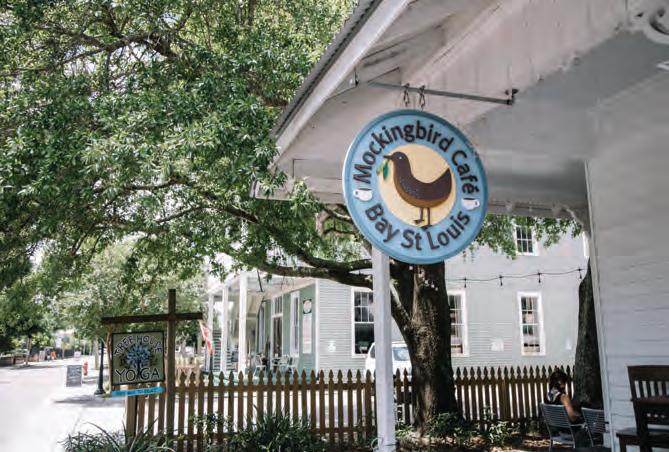
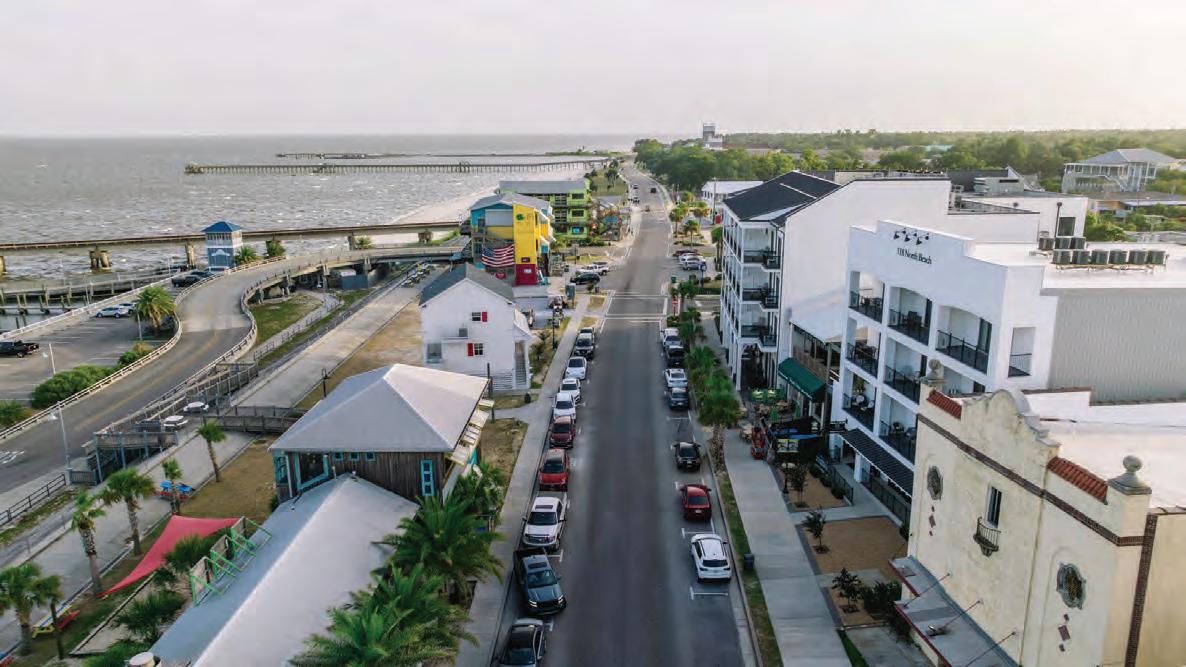
A GULF COAST TOWN REDISCOVERING
By Mimi Greenwood Knight
When I was a girl, everybody’s grandparents had a weekend place in Bay St. Louis. Although ours was across the bridge in Pass Christian, we spent many a summer day crabbing in the Bay and running barefoot through the town sucking down snowballs and corndogs. Bay St. Louis circa 2024 is a bit more sophisticated. But the quintessential y’all-comeback-now-ya-hear friendliness of its residents has held fast.
As long as anyone can remember, the Mississippi Gulf Coast served as a summer playground for New Orleanians longing to escape the city. That is until 2005, when Hurricane Katrina slammed ashore, all but erasing the tiny coastal communities from the earth. The sixty-two miles of coastline along the Gulf of Mexico was left unrecognizable with nary a home or business standing. In many cases, even the beaches themselves were washed away.
Yet, in the years since, tenacious Gulf Coasters have crawled out from under the wreckage to rebuild their towns and, in many cases, redefine them. Today, places like Bay St. Louis, Mississippi are more charming, more funky, and more nuanced than ever. And judging by the national headlines declaring the Bay the “Best Girlfriend Getaway”, “Best Honeymoon Destination”, one of the “Best Small Towns in the South”, and “Best Coastal Towns” I’m not the only one who thinks so.
When trip planning, it’s hard to find a weekend on the calendar when there isn’t a festival in Bay St. Louis—often requiring a costume. The second Saturday of each month, the city hosts an art walk that has been organized by the Old Town Merchants Association for over thirty years and features food vendors, street musicians, and gallery openings.
Coming up, there’s Frida Fest, scheduled for July 13 this year, where townsfolk and visitors break out their best Frida Kahlo costume. The day is jampacked with Frida-themed fun including a Frida 5Kahlo run, special Frida food and drink, a Frida look-alike contest and parade, and art demonstrations with all proceeds going to charity.
The first weekend in September, the historic 100 Men Hall hosts Booker Fest—honoring the musical genius of James Booker. Then, fall festival season comes to a head in October with Cruisin’ the Coast—drawing hundreds of nostalgic hotrods to Bay St. Louis for “America’s Largest Block Party”.
A few weeks later, just before Halloween, the antique cars are replaced by witches and warlocks for the Witches Walk. In November, 100 Men Hall hosts a Veteran’s Day fundraiser called “Cigars Under the Stars” featuring local cigars for sale and live music performances. Celebrations continue through January, when, in honor of Dolly Parton's birthday, the town fills with Dolly lookalikes for Dolly Should (because Dolly should
spend her birthday in the Bay one year). May brings in offroad enthusiasts for Jeepin’ the Coast and a host of buccaneers for Pirate Day in the Bay, a weekend festival hosted by the Mystic Krewe of the Seahorse in which “pirates” invade and host a series of events including live concerts, parades, costume contests, and more. And June brings Caftans and Cocktails, a popular bar crawl which sees the town flowing in floral fabric and gaudy accoutrement as girls and guys dress as Mrs. Roper from Three’s Company
Less than an hour from New Orleans, this soulful little waterfront community has always associated itself more with the Crescent City than with the rest of Mississippi, echoing New Orleans’s spirit in its architecture, cuisine, music, and nightlife. (Cocktails in go-cups? No problem.) The Bay today offers live music seven nights a week in its bars, restaurants, and casinos. Golf carts are parked bumper to bumper along Beach Boulevard, dogs welcome everywhere, and most of the crowd holds a libation in their hand. Come the weekend, you’d be hard pressed to find a bar or restaurant that isn’t hosting a bachelor and bachelorette party. And of the summer cottages and bungalows that did survive Katrina, many are now bed and breakfasts, at least part of the time, welcoming guests from around the globe.
Our accommodations at the luxurious Pearl Hotel included a showstopping sunrise over the harbor directly across from our balcony. Along the lively Beach Boulevard, restaurants like 200 North Beach, Cuz’s, The Thorny Oyster, The Blind Tiger, and Beachside at Bouy’s offer Gulf-to-table cuisine including crabs, oysters, and many types of fish fresh from the waters only feet from where you sit, with Royal Red Shrimp reigning as king.
When you visit The Bay, plan to leave extra space in your suitcase or car. The highly-walkable downtown is crammed with art galleries, antique shops, gift shops, and clothing boutiques. The Shops at Century Hall feature three rambling stories of antiques, gifts, and original artwork. In Gallery 220, find creations by multiple Gulf Coast artists and artisans. If you’re looking for a playful gift for friends back home, don’t miss Social Chair, an Old Town staple filled to the brim with jewelry, home décor, and one-of-a-kind gifts. And Fleurty Girl’s Bay St. Louis location adds some South Mississippi flavor to its popular NOLA gear and googa.
My niece from Atlanta and daughter from New Orleans swear they find the same clothing brands they love in the Bay, but for considerably less. We especially enjoyed Bay-Tique, with its upscale resort-wear collection, and California Drawstring, a cotton, linen, and silk clothing line with origins at the 1984 World’s Fair in New Orleans. The circa-1928 L & N Train Depot is a must-stop. Inside, discover a Mardi Gras museum (There’s that NOLA influence again.), as well as the delightful Alice Moseley Folk Art & Antique Museum on the second floor, with over eighty works by the iconic Mississippi folk artist and humorist. Both are free.

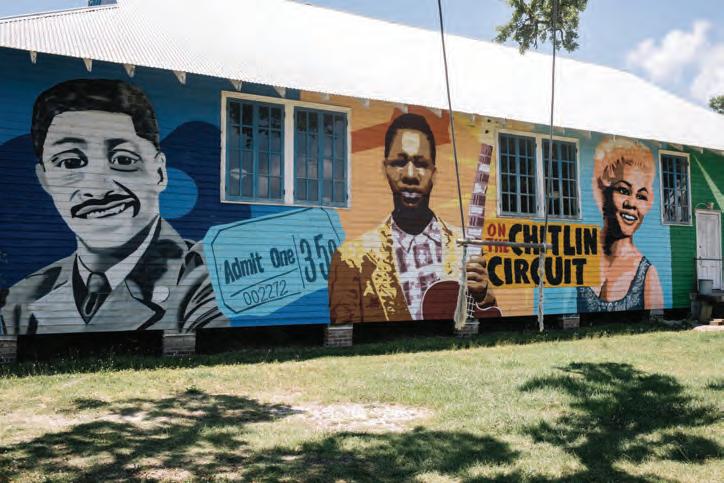
During my stay, my sister and I enjoyed two walking tours. The “Taste of Time Food Walking Tour” took us through Old Town and the Depot District while we listened to tales of Bay St. Louis from the Civil War era until now, popping into predetermined locations for samples of the food and drink of the area. The tour included sample portions of roast beef po-boys from the Butcher Shop, sausage and chicken gumbo from The Blind Tiger, and pralines from PopCorn Plus—followed by coffee at PJ's Coffee.
That night, we met our ghoulish guide on the waterfront for the Mystic Ghost Tour, which unveiled some goosebump-worthy tales, such as that of the Union soldier who’s often seen under a massive oak in a certain courtyard and the last man hanged in Mississippi, who peers from the old courthouse windows at night. We were disappointed not to see any specters ourselves, but it was a lovely night and amazing to realize that three women could stroll around town in the dark with no fear for our safety.
Begun in 1894 by a group of local African American men, 100 Men Hall was originally established as a death and burial association (DBA). It emerged as a place for the local Black community to come together, pool their resources, and take care of one another during a dark time in the state’s history. Over the years, 100 Men Hall has been many things, including a dance hall and juke joint that helped launch the careers of music greats such as James Brown, Ray Charles, Etta James, Ernie Kato, James Booker, Sam Cooke, Tina Turner, and B.B. King. Today, the hall is open for live music events, weddings, tours, and an eclectic assortment of festivals.
Just a short drive from the Hall is St. Augustine Seminary, founded in 1923 by the Brothers of the Divine World Missionaries with the sole purpose of educating African American, and later Vietnamese and Hispanic, men to enter the Catholic priesthood. Even today, many of the Black priests and brothers in this country obtained their training at St. Augustine, and nine of its graduates have become Catholic bishops. The chapel, buildings, and extensive grounds now operate as a retreat center. Just across town is another such significant site, St. Rose de Lima Catholic Church, which was originally established in the 1860s as a school for African American children. Weekly mass is still celebrated there.
Beyond the shopping and historical sites, you can also enjoy Bay St. Louis’s many outdoor amenities. Schedule a sunset champagne cruise, rent a kayak, charter a fishing boat, visit the casino, play some golf, or just enjoy a little downtime in a soulful coastal community. Learn more at coastalmississippi.org.



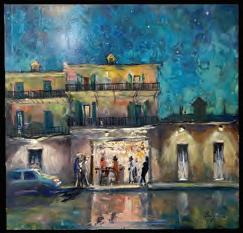




Baton Rouge, LA
Amy James Photography 34
Allwood Furniture 16
Baton Rouge Clinic 13
Becky Parrish Advance
Skincare 52
Blue, Gray, and Bayous
Guided Tours 51
Blue Cross Blue Shield 20
Calandro’s Select Cellars 45
East Baton Rouge Parish
Librar y 60
Elizabethan Gallery 55
Lake Urgent Care 25
Louisiana Public Broadcasting 52
LSU Museum of Art 9
LSU Online and Continuing Education 49
LSU Rural Life Museum 24
Mary Bird Perkins Cancer Center 43
Pennington Biomedical Research Ctr. 7
Tigers Trail RV Resort 46
WRKF 89.3 FM 55
Breaux Bridge, L A
St. Martin Parish Tourism Commission 18
Brookhaven, MS Brookhaven Tourism Council 22
Hammond, LA
Tangipahoa Parish CVB 59
Houma, LA Houma Area CVB 17
Jackson, MS Visit Mississippi 5
Lafayette, LA
Allwood Furniture 16 J & J Exterminating 29
Lake Charles, LA Louisiana Food and Wine Festival 19
Mansura, LA Avoyelles Tourism Commission 30
Morgan City, L A Cajun Coast CVB 39
Natchez, MS
Katie’s Ladies Apparel 22
Monmouth Historic Inn 23, 33
Natchez Chamber of Commerce 3
Natchez Convention Promotion Commission 23
Natchez Garden Club 11
Natchez Olive Market 22
New Iberia, LA Iberia Parish Convention and Visitors Bureau 21
New Roads, LA City of New Roads 49
New Orleans, LA Historic New Orleans Collection 27 Visit Jefferson Parish 2
Opelousas, LA
St. Landr y Parish Tourist Commission 51
Plaquemine, LA
Iber ville Parish Tourism Department 12
Port Allen, LA
West Baton Rouge Museum 46
West Baton Rouge Convention and Visitors Bureau 14
Port Arthur, TX Visit Port Arthur 10
Scott, LA
Bob’s Tree Preservation 30
St. Francisville, LA Cross Quilter 51
Poppin’ Up Plants 55
Louisiana Hospitality Group 6
Magnolia Cafe Inc. 42
St. Francisville Food & Wine Festival 15, 57
Town of St. Francisville 42
West Feliciana Animal Humane Society 39
Zachary, L A
Lane Regional Medical Center 28


The annual St. Francisville Food & Wine Festival is a weekend-long celebration of the culinary culture of Louisiana and Mississippi with acclaimed chefs, creative wine pairings, cocktail and spirit tastings, craft beer and live entertainment in one of Louisiana’s most beautiful and historic small towns.
Three days of Food & Wine Festivities:
Friday, November 8
Jazz Brunch at the St. Francisville Inn Winemaker Dinner at Magnolia Café featuring Eberle Winery
Saturday, November 9
Bubbles and BBQ at North Commerce
Mad Hatter Soirée at the Royal Inn
Sunday, November 10
St. Francsiville Food & Wine Festival Grand Tastings at The Myrtles







By Mathilde Fox-Smith
The world of Cecelia Moseley’s art is steeped in the whimsy of childhood. In her recent solo exhibition Overlay: Language Uncovered at the LSU School of Art’s Glassell Gallery, jumbles of curling cursive letters in vibrant colors splayed over the white gallery walls, dangled from the ceiling, and spilled across the floor. Daylight filtered through a lens of yellow vinyl onto ridged Styrofoam in the installation piece, “Life through a Yellow Lens''. In another installation, “Cognitive Perception,” projector light cast colorful shadows behind a coiled silver form suspended in midair.
A native of Meridian, Mississippi, Moseley recently graduated with an MFA in Sculpture from Louisiana State University, but her passion for art stretches far back into her younger years. She re members a childhood filled with painting and, notably, the early endeavors in sculpture: she would scavenge for colorful telephone wires in her dad’s tool shed and bend them into the shapes of in sects and butterflies, then tie them to the fan in her room, high-speed, to watch them bob and spin around.
Today, Moseley’s creative process has retained this imaginative spirit. “I used to describe my studio practice as an act of play, so kind of going back as a child and experimenting and exploring as if I was doing that in my room when I was younger,” she explained. As a mixed-media artist, she is constant ly experimenting with materials: acrylics, vinyl, Styrofoam, paper, metal, mesh fabric, and light have all passed through her studio into her pieces. Often, this process involves stumbling upon new possi bilities by accident. The textured Styrofoam featured in pieces such as “Life through a Yellow Lens” was conceived when Moseley tested spray paint on the slabs of the shipping material lying around the studio—and, much to her surprise, the paint ate the surface of the Styrofoam away.
The playfulness of Moseley’s art coexists, inextricably, with another aspect of childhood that she confides in her viewers: that for her, these young years also bore challenges, patterned by the expe rience of growing up with dyslexia and ADHD. The bright acrylic cursive shapes that pour across the gallery wall in her piece “Language of Escape” recall the abstract words she used to sketch on the margins of her notebooks to distract herself from the frustration of the classroom: the exasperation of constantly being pulled out of class, requiring special help during tests or with reading assignments, or attending tutoring after school while other children played at home.
These memories, much like her materials, are reshaped and reappropriated through Moseley’s art practice. “The tools I used growing up are now an aesthetic thing in my work,” she said. The yel low film produced by light and vinyl in “Life Through a Yellow Lens” repurposes the yellow overlay bookmark she used for reading to reduce distortions of text. The color yellow is unique to her, Mo seley explained: every dyslexic individual is different, and must find the overlay color that works best for them.
The depth of personal experience that infuses Moseley’s artwork has made the process extraordi narily meaningful but, she confessed, not without moments of doubt. Last summer, she experienced a stage of questioning: did she still want to center her creative energy around dyslexia and ADHD? Was it time to jump ship and embark upon something completely new?

Around that time, Moseley took a trip to Decatur, Indiana to install a sculptural piece titled “Panel Installation” for the the downtown Decatur Sculpture Tour. While she was working, an older man approached her. His granddaughter had dyslexia, he explained, and it had been so impactful to read and to hear her story that his daughter was coming to Decatur in the next few weeks to view her pieces with his granddaughter.
“It was one of those things,” Moseley says, “Having someone older, water in their eyes, explain to me how much this piece means to them, and his granddaughter just got diagnosed … It just reaffirmed, like, this is what I’m supposed to be talking about, this is really important, and it continues to make me emotional and to make me connect with people.”
That ability to forge connection and to make others feel less alone—that is the power that brings Moseley’s work to life, and inspires her to keep creating. “I am very thankful for the parents and teachers and tutors that helped me get to where I am today,” she said. “Appreciating and celebrating that is what my work is more about now, rather than the darker struggles.” The wonders and challenges of growing up converge in Moseley’s art to create a nuanced, colorful, and moving portrait of her childhood. But today, she speaks with the perspective of an adult who has grown through her experiences and is feeding the power and beauty of that support back into the world. •
In the fall, Moseley will return to LSU as an adjunct professor, teaching two 3D Design classes and one Introduction to Sculpture course. In August, she’ll install a public artwork for the 2024–2026 exhibition at the Matthews-Sanders Sculpture Garden, followed by another in October for the 2024–2025 Rosemary Beach Sculpture Exhibition in Florida. She also has an upcoming exhibition, Layered Overlays, which will be on display at the Gumtree Museum in Tupelo, Mississippi from September 5–30. You can find her art at cmoseleyfineart.com or @cc_art_design on Instagram.



